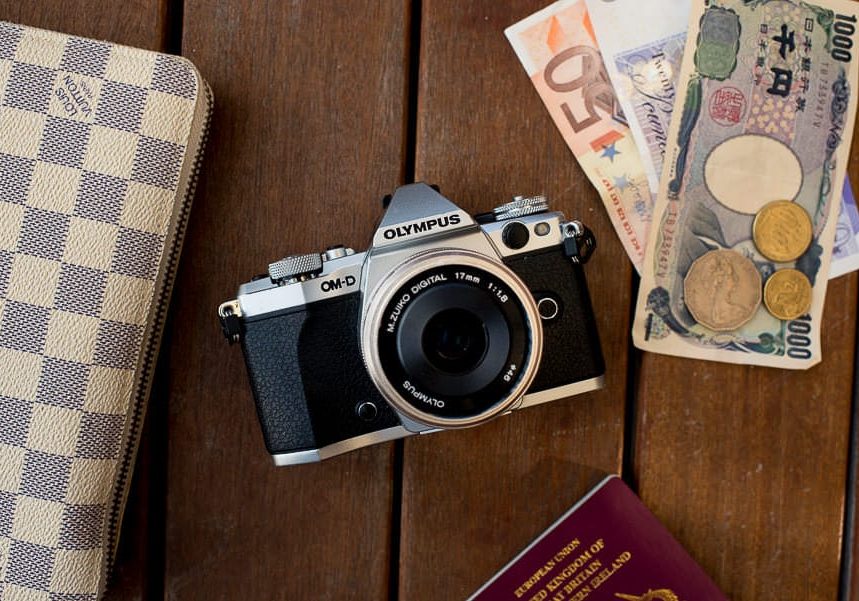
Olympus OM-D E-M5 Mark II Camera Review
In-depth review of the Olympus OM-D E-M5 Mark ii camera with travel photos. The best camera for travel photography & street photography is put to the test.,
This is a review of the Olympus OM-D E-M5 Mark II. I had a bit of trouble deciding what to title the post though…
You see, after using the Olympus OM-D E-M5 Mark ii solidly for a month whilst traveling in Europe, I am confident that this little camera is one of the best travel cameras available today.
By this I mean a camera that is small, light, weather-proof, tough, fast and of course, takes a great picture. If it’s affordable too, that’s a big plus.
Despite the emergence of many other great micro-four-thirds cameras over the years since the release of this, the OM-D E-M5 Mark II continues to be one of my favourites.
Olympus OM-D E-M5 Mark II Review
Here’s a condensed version of this review. If you are:
a) someone who doesn’t know anything about cameras but wants to take great photos
b) a pro who wants a second camera for travel/street photography/fun (e.g. me).
c) someone who wants arguably the best compact camera for professional photographers
Here is all you need to know:
The Olympus OM-D E-M5 Mark ii allows you to take interesting and creative photos much easier than any other camera I’ve ever used. It makes photography easier and it makes it a lot of fun.
If you have $1,000 to invest in a compact camera that has better functions than any DSLR and excellent image quality, the Olympus OM-D E-M5 Mark ii is the camera to get.
Unless you’re a pro or a serious hobbyist, don’t waste your time with a DSLR, especially if you’re a parent. Trust me on this – a bulky camera will never leave your camera bag.
Save Time – Here’s My Recommendation
If you wanted just one all-round lens, I’d go with this body + Olympus 12-40mm f/2.8 lens kit for the most versatility.
As for other lens options, if you’re a prime lens user, I’d recommend the Olympus 17mm f/1.8 to start with, the Olympus 12mm f/2 as a wide angle and the Panasonic 42.5mm f/1.2 if you want some amazing low light performance.
If you prefer the convenience of zoom lenses, I’d recommend the amazing Olympus 40-150mm f/2.8 and the Olympus 12-40mm f/2.8 – with those two, you’re pretty much sorted for wide angle all the way through to telephoto.
Check out more of the best Micro Thirds lenses for my opinion on the best bang for your buck MFT glass ;-)
If you’d prefer to shop with B&H Photo, click the button below to read more reviews on the Olympus OMD-EM-5 Mark II and get the best price there.
My Experience with Mirrorless Cameras

Left: Olympus OMD-EM5 Mark II | Right: Fujifilm X100S
I wasn’t expecting to like the Olympus OM-D E-M5 Mark ii. I’ve tried plenty of mirrorless cameras, and they all seem to annoy me, usually in one important aspect – the autofocus.
I own the pseudo-range-finder Fujifilm X100V camera, which is extremely popular (especially amongst pros) for its gorgeous looks, a high speed leaf shutter which allows you to do incredible things with flash, and most importantly the incredible image quality you can get straight out of camera.
However, I don’t care what anyone says, the auto focus on the Fuji is still a little lacking. I use single point AF, and whilst the Fujifilm X100V keeps up in decent light, it’s still way slower than any dSLR to grab focus.
Then there’s the auto focus for moving subjects…omg. Anyone who says the X100V is great for street photography is obviously shooting things that are static, which in my opinion isn’t real street photography.
The much loved Fujfilm XT-1 has slightly better AF (especially with recent firmware updates), but it’s still nowhere near a DSLR.
I agree completely that these type of mirrorless camera can be used professionally, but only if the subject is static. Wedding Photographers who use the XT-1 are, in my opinion, sacrificing a lot of the story in favour of still shots.
So in summary, I think small mirrorless cameras are great. They’re small and can produce excellent quality images. However, the focus system on any DSLR is usually far better.
That is, until now…
The Olympus OM-D E-M5 Mark ii – Intro
There are a few caveats, but here’s why I think the Olympus OM-D E-M5 Mark ii is:
- the best mirrorless micro 4/3 camera
- the best camera for travel photography
- the best camera for street photography.
Rather than bore you with an in-depth review of every detail of the Olympus OM-D E-M5 Mark ii, I’ve decided to highlight what are in my opinion the most amazing features of this camera.
Then I’ll round it off with what I didn’t like so much.
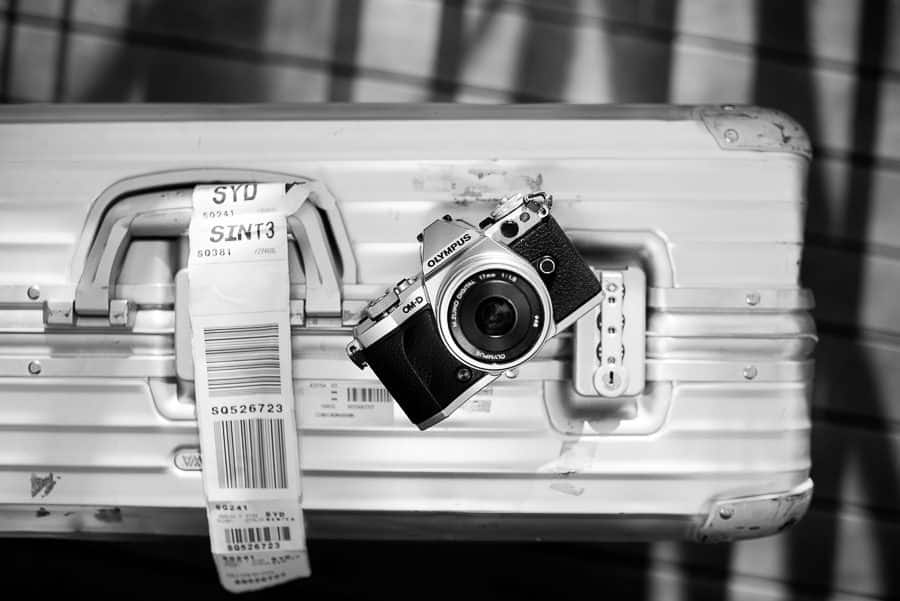
I’ve included photos I took on my one month family holiday around Europe. Bear in mind that I was always with 3 other people and our baby, so had little time for each shot.
I think this makes the review more realistic, and hopefully shows what you can achieve with the Olympus OM-D E-M5 Mark ii as a travel camera in an everyday situation.
Olympus OM-D E-M5 Mark ii – What I liked
1. Size/Weight
Let’s get this one out the way first. Mirrorless cameras are much smaller and lighter than dSLRs. I wouldn’t say they’re ever ‘pocketable’, but you can hang one around your neck or off your wrist all day without any issues (this is what I did).
The Olympus OM-D E-M5 Mark ii allows you to change lenses. There are lots of lens options available, but I chose the excellent Olympus M.Zuiko 17mm f/1.8 which balances perfectly on the Olympus OM-D E-M5 Mark ii.
Sticking a heavy zoom on a camera of this size kinda defeats the purpose for me, so I wanted to couple the Olympus with a prime (non-zoomable) lens, and the Olympus M.Zuiko 17mm f/1.8 fit the bill perfectly.
The field of view is roughly 35mm which is a perfect all round focal length, and the lens is sharp and fast. It also exhibits some lovely flare.

I won’t dwell on lens choice as it’s very subjective, but if you want my advice, invest in the Olympus M.Zuiko 17mm f/1.8 and leave it on your Olympus mirrorless camera forever. Just because you can change lenses doesn’t mean you have to ;-)
As for the weight, the Olympus OM-D E-M5 Mark ii + the Olympus M.Zuiko 17mm f/1.8 is 648g (467g + 181g). By comparison, the average dSLR + lens is well over 1kg.
A camera needs to have a certain weight to it, otherwise it feels too much like a toy, and can actually be harder to use. The set up I described above is just right – not too heavy, not too light, and very well balanced in the hand.
2., Image Quality – JPEG
How a photograph looks is pretty much the most important factor when buying a camera. There are so many cameras that are a pain in the ass to use, but the image quality is so good (or has some intangible quality to it) that we put up with the shortcomings of the camera body.
I own the Fuji X100S and I’ll be the first to admit that it’s very annoying to use. The original X100 was way, way worse, but it still sold like hot cakes. Why? Because the image quality is excellent.
When I got hold of the Olympus OM-D E-M5 Mark ii, I knew that the body would blow the Fuji out of the water. It just felt right in my hands. However, I thought that the image quality would fall short.
I thought that I wouldn’t have the confidence to shoot it in jpeg mode like I do the Fuji, safe in the knowledge that White Balance wouldn’t need correcting in post, and the jpeg colours would be good enough to be usable straight out of camera.
How wrong I was.
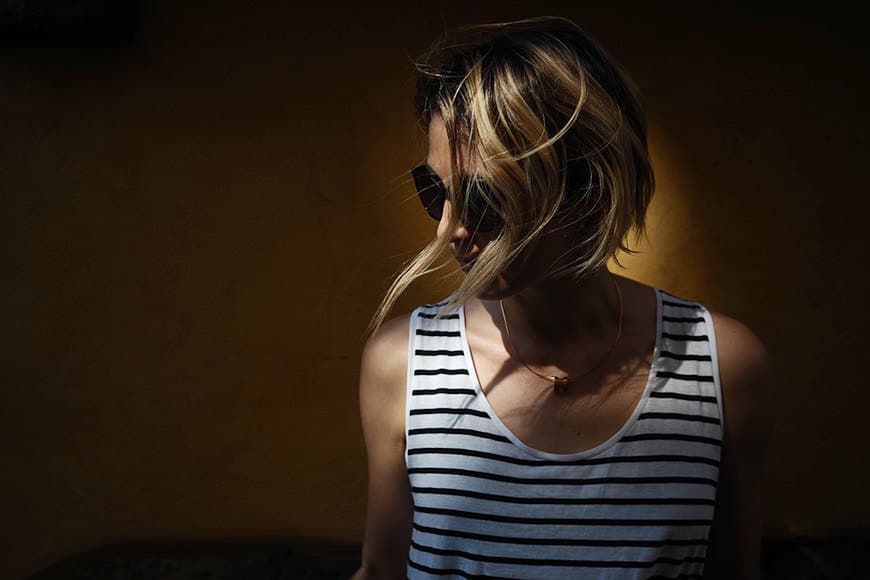
This looks like it’s been edited but it hasn’t – it’s just a nice pocket of light down an uninteresting street.
Remember, these are JPEGs that are straight out of camera. All I’ve done is added contrast and sharpening in the camera’s settings, and resized them for this site.
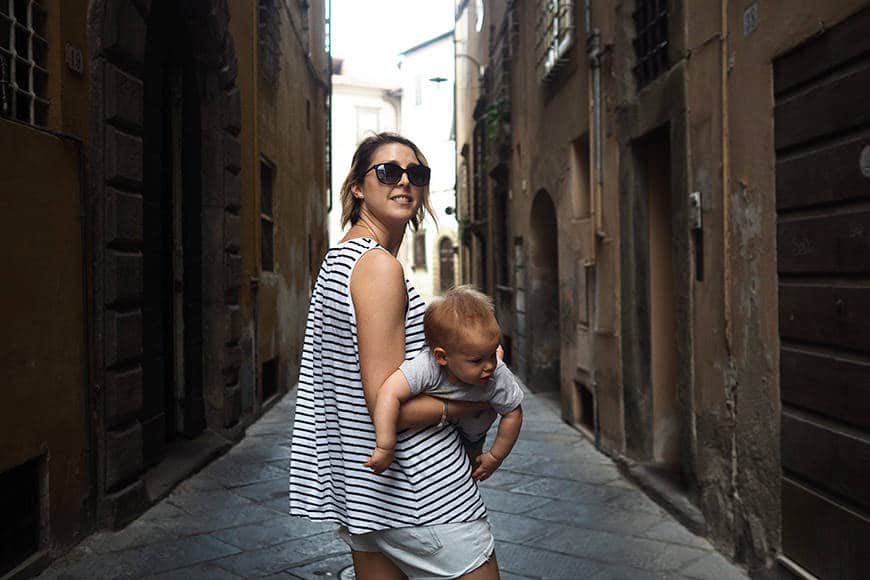
An alleyway in Lucca, a beautiful little town in Tuscany.
Sure, they lack a bit of punch, but I still think the quality is very good considering there’s zero post processing, which meant zero time spent sitting in front of a computer for me :-)
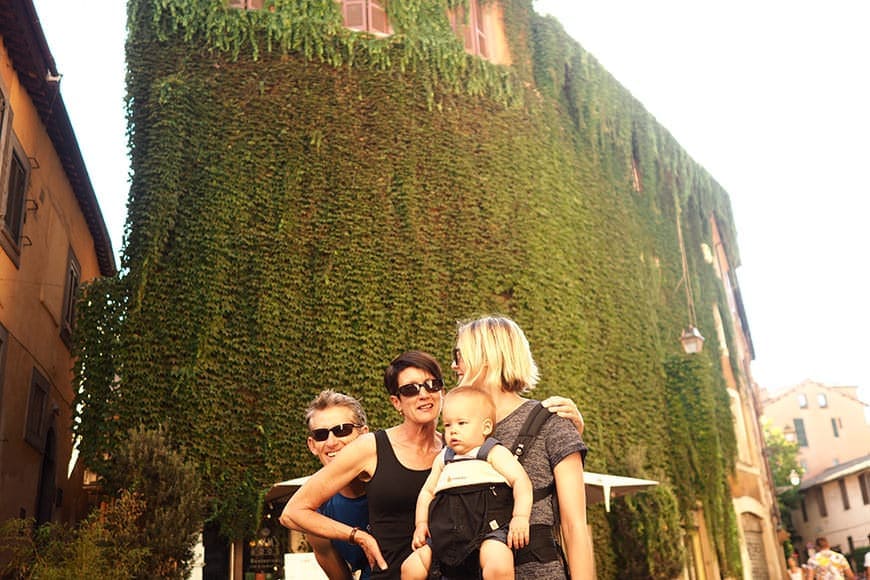
The Trastevere neighbourhood on the west bank of the Tiber in Rome – highly recommended!
You may think the above photo looks a bit orange, but the afternoon light in Tuscany really is that colour – it’s beautiful. The Olympus OM-D E-M5 Mark ii nailed the white balance.
3. Image Quality – RAW
I shoot the Olympus OM-D E-M5 Mark ii on the RAW + JPEG Fine setting. That way I don’t have to waste my time editing any RAW files if I’m happy with how the JPEG looks, but I still have the RAW files to fall back on should I need to dig deeper into the dynamic range of the file, or fix the white balance.
If you can’t be bothered to mess around with the images on your computer after shooting them, just set the camera to JPEG and you’ll get great looking photos.
However, for those of you who’d like to see what this camera is capable of when you really push the RAW files, below is a test image I shot heavily under exposed (it was basically complete black), then brought back by 4 stops in Lightroom.
Ignore the bottom of the picture – it’s the edge of the wharf I was shooting from.

By comparison, here’s the same underexposed -> recovered image with my Nikon D750 (review), a full frame camera costing twice as much:
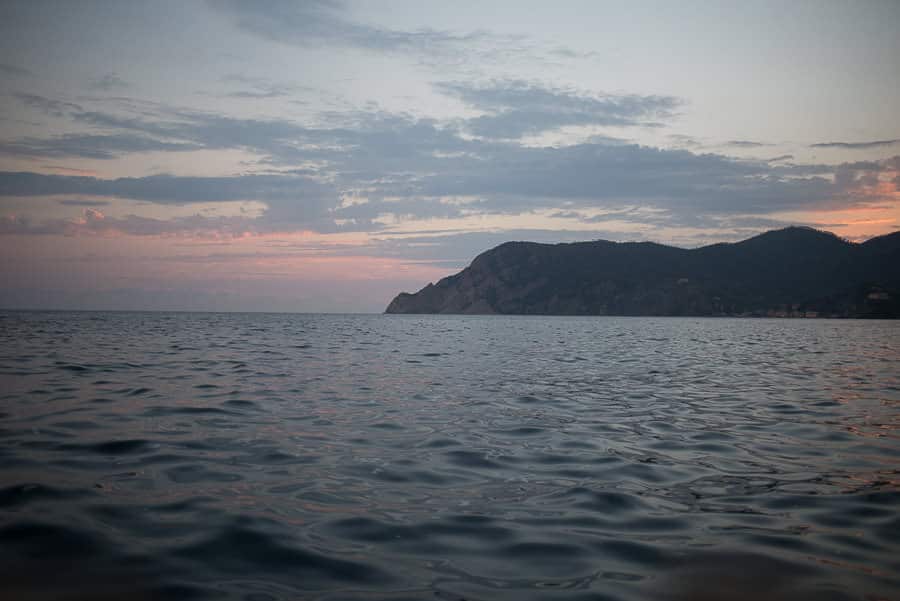
It’s only when you start peeping into the shadow detail that you notice the Olympus’s file struggling, but this is to be expected of a sensor that’s less than half the size (and cost) of the Nikon D750.
That’s the thing with this camera – you often forget that it’s a Micro 4/3 sensor, way smaller than a dSLR’s. The RAW files simply can’t contain as much data in them, so you can’t push and pull them to extremes like you could a full frame camera.
However, if you accept this, the RAW files out of the Olympus OM-D E-M5 Mark ii are excellent and you can have a lot of fun post processing them in Lightroom or Photoshop.
Here are some snaps from my holiday to give you a bit of an idea of what this camera is capable of.

Singapore Airport where we stopped to get a much needed break from the mammoth flight.
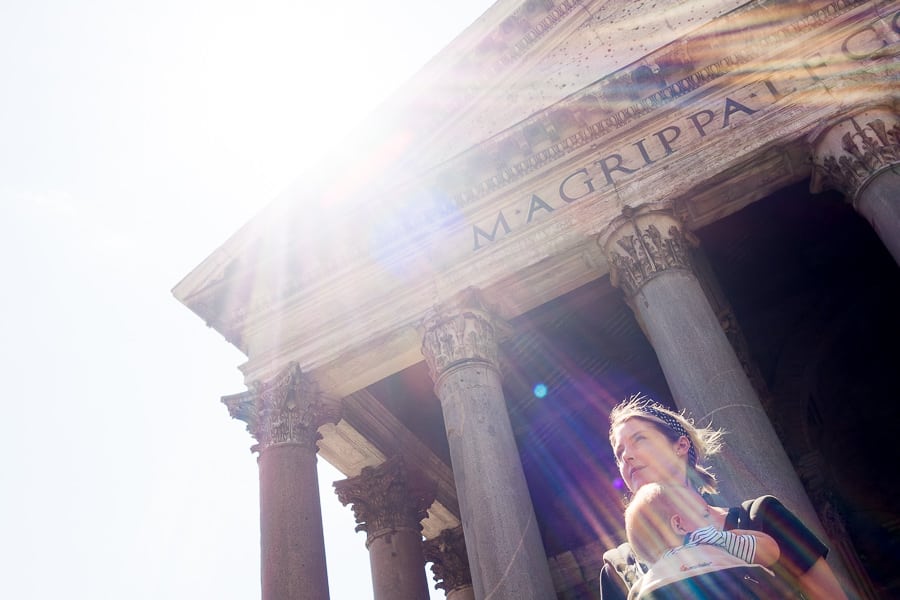
The flare from the Olympus 17mm f/1.8 is great!
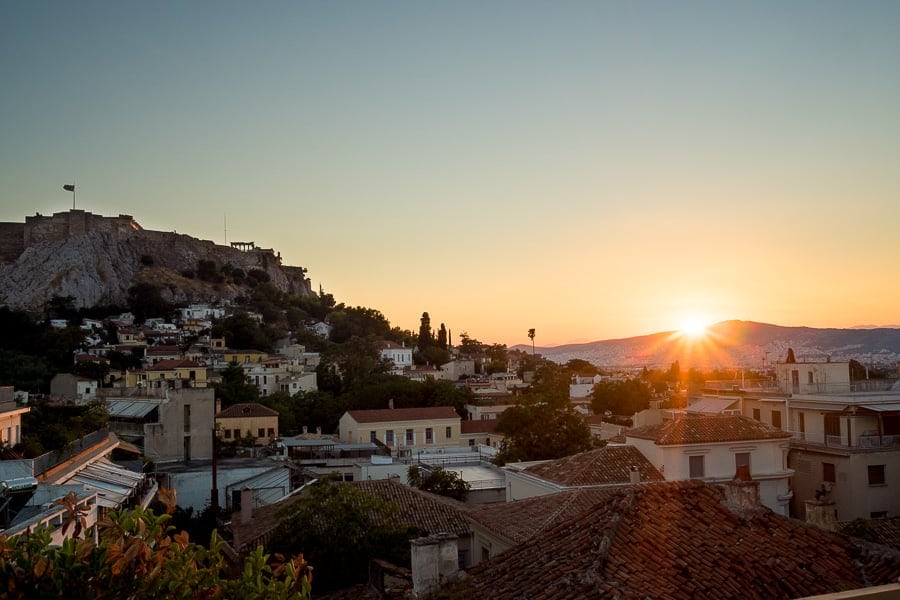
Athens at 7pm – I was exposing for the sun in this shot, so pulled back some detail from the shadows in post.
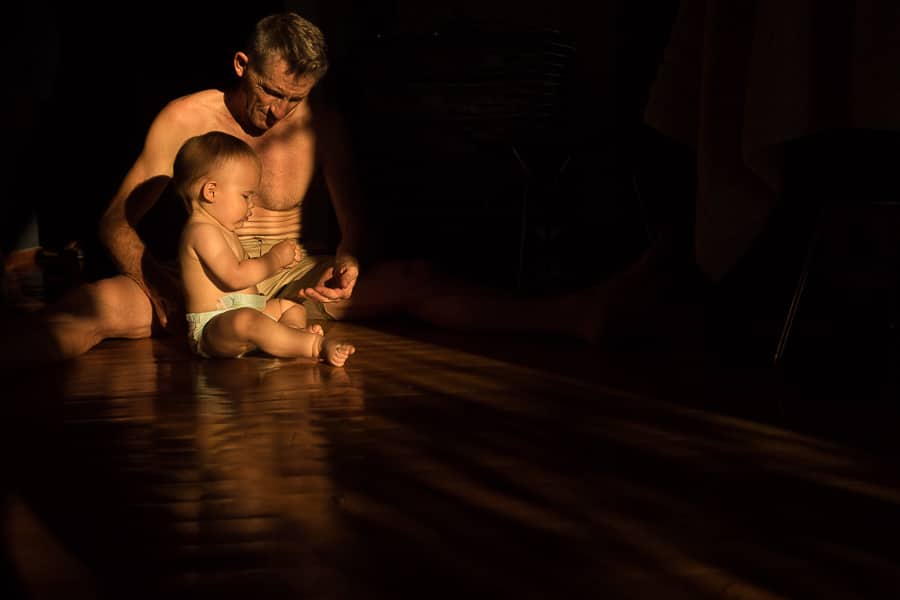
Being able to preview the exposure on the LCD screen makes hunting for interesting light especially fun.
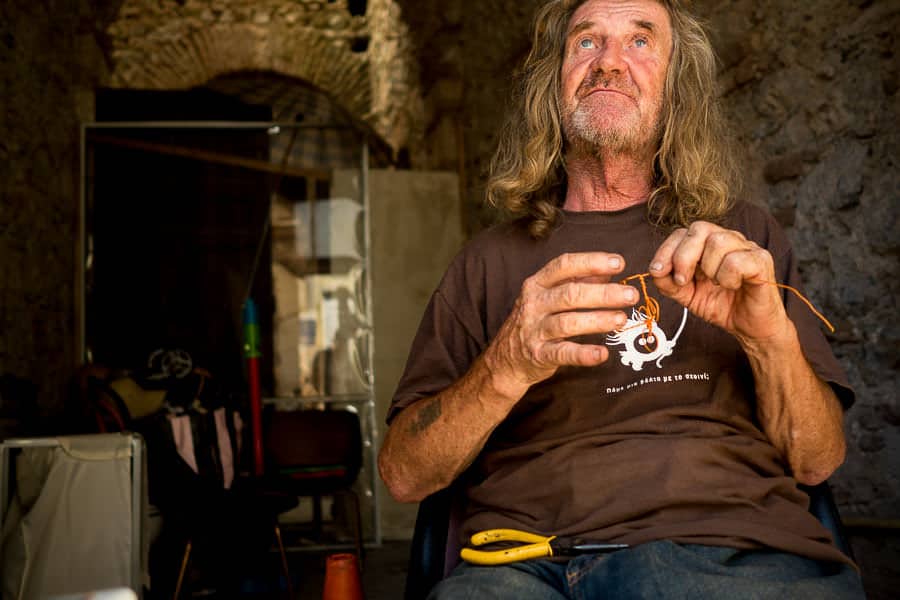
This is Tom who makes his living on a street corner in Athens, selling bicycles made out of wire for 1 Euro!

Harry gets a telling off! Underexposing is a cinch with live exposure preview

The Olympus retains a surprising amount of highlight detail for a small camera.

Shot from the ground – the sun shades of the cruise boat on the Bospherus in Istanbul

Here I tilted the screen 180 degrees and shot backwards

This is how the camera/lens handles a heavily backlit portrait
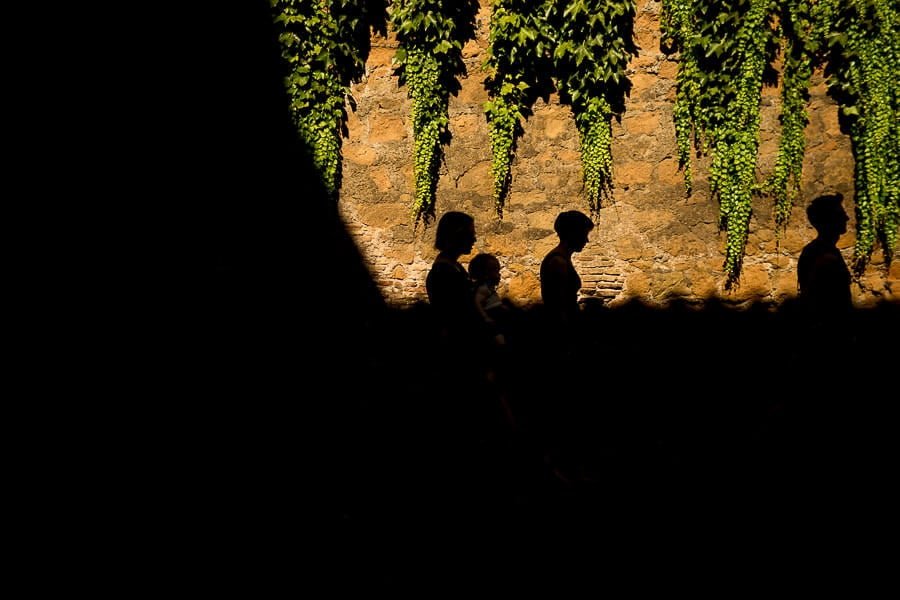
Exposing for the highlights is so easy on a camera with exposure preview

As the Olympus doesn’t need to be shot at your eye, you can get candid photos like this much easier

An example of the awesome bokeh at f/1.8 of the Olympus 17mm f/1.8 lens

Violinist on the streets of Florence
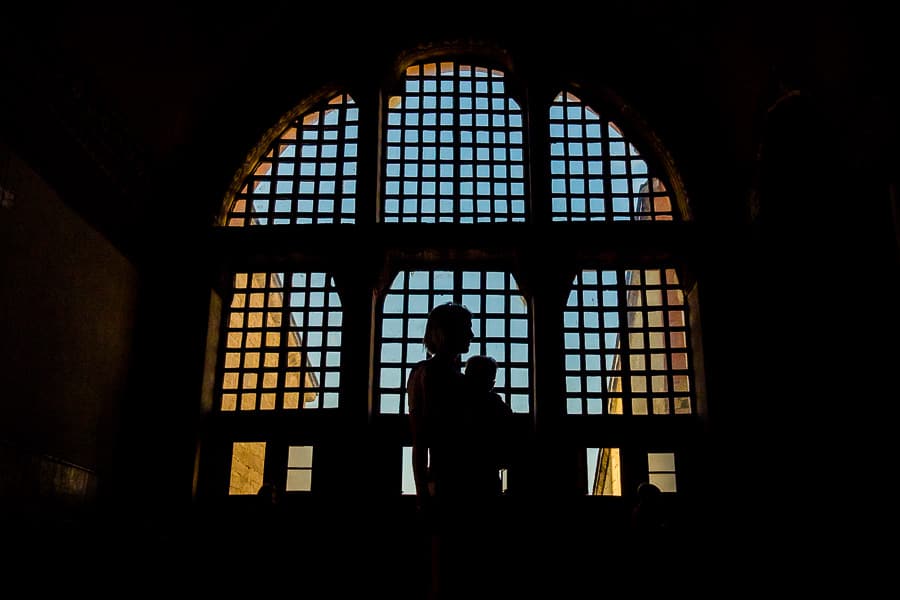
Inside the Hagia Sophia mosque in Istanbul
4. Flip Out Screen
Flip out (articulated) screens are in my opinion the most under rated feature on cameras today. In fact, the flip out screen on the Nikon D750 was one of the main reasons I got a couple for my wedding photography work.
At first you might think that having a flip out screen is a gimmick, but the more you use one, the more you’ll realise how many creative doors it can open.
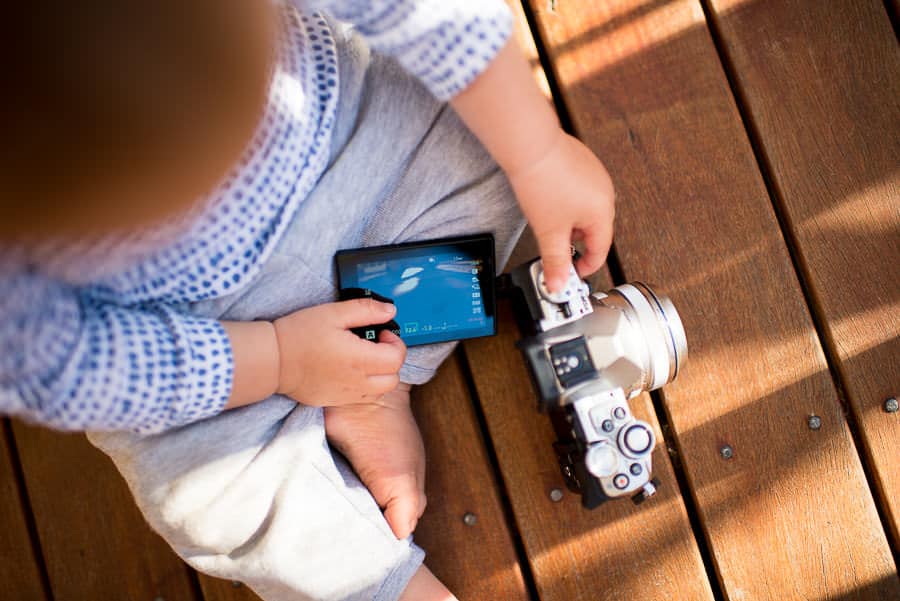
It’s so easy to take a photo using the flip out screen, even my 1 year old can do it!
The original Olympus OM-D EM-5 had a 90 degree flip out screen, but the new Olympus OM-D E-M5 Mark ii allows the screen to be flipped and swivelled 180 degrees.
I really don’t want to use the word ‘selfie’, but being able to compose a shot pointing the camera at yourself can be handy, and if you have children it’s especially fun.

My son and I at Lake Vouliagmeni in Athens – the fish in the lake nibble at the dead skin on your body!
Shots like the ones below would have been very awkward without the flip out screen of the Olympus.
The screen encourages you to take photos from unusual angles, allowing you to get very close to the ground for some creative perspectives.

The Duomo in Milan – luckily the rain meant the queue was only 1/2 hour rather than 4 hours!
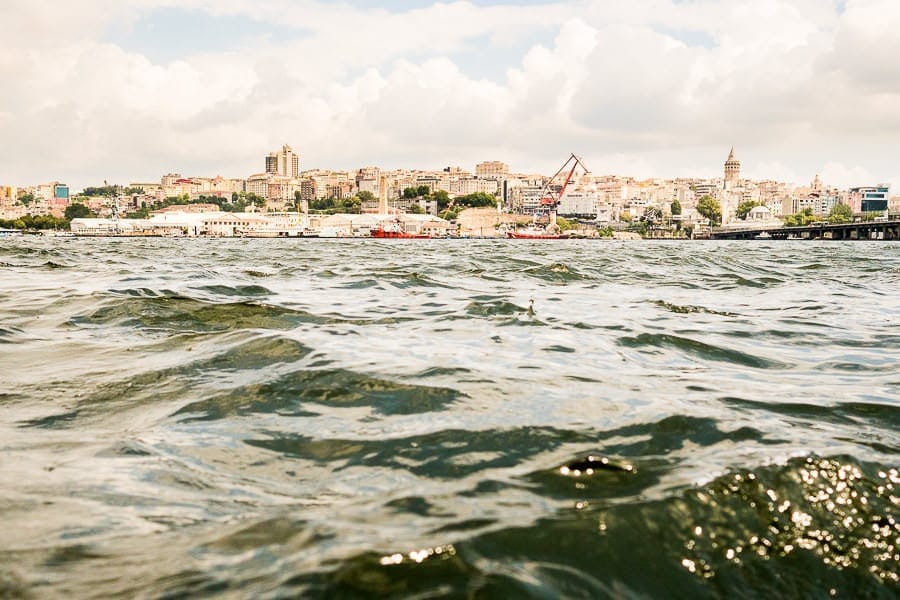
Istanbul from the Bosphorus River. This shot taken was 1 inch from the water. The weatherproof body of the Olympus helps with splashes.
However, having a flip out screen is only part of the equation of the awesomeness of the the Olympus OM-D E-M5 Mark ii!
The other feature that goes hand in hand and makes this camera the best camera for street photography (as well as all kinds of other ‘stealthy photography genres) is…
5. Touch Screen Focus/Shoot
I’m so excited to about this feature! Every time I use it I love the Olympus OM-D E-M5 Mark ii a little bit more!
Ross Harvey who uses the original Olympus OM-D EM-5 for street photography showed me this feature last year.
When you try it in person though, it’ll blow your mind! It really does make every other touch screen camera seem dated in comparison, and also makes the Olympus OM-D E-M5 Mark ii very easy to use for anyone.

The ice cream vendors in Istanbul put on a show for every customer which consists of snatching the ice cream from your hand until you’re sick of it!
So what do I mean by ‘touch screen focus/shoot’? Well whilst anyone with a mobile phone is familiar with touching the screen to tell the camera where to focus, but the Olympus OMD cameras take this one step further by focusing, exposing and taking the photo all in a millisecond.
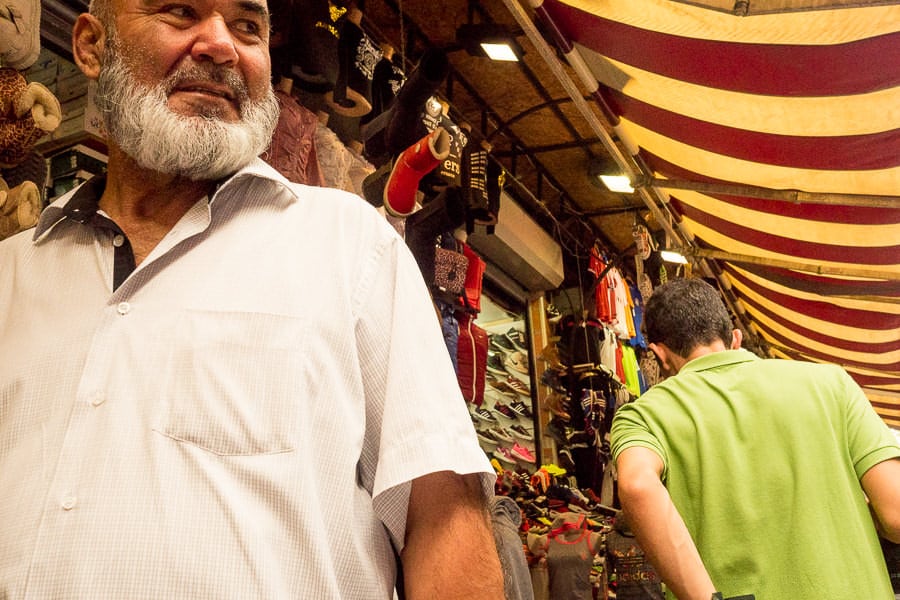
If you’d like to control the exposure, you can of course do this in Manual mode, but just to illustrate how useful this feature is, imagine being outside with the Olympus. You’ve swivelled out the flip screen so you can look down onto it and shoot from the hip.

People around you would think you’re just checking your photos, but little do they knew, you’re composing your shot so that when an interesting subject walks past, you touch them on the screen and BAM! Focus and Shot in less than half a second!

If you’ve got the sound off (incidentally, the shutter sound effect is gorgeous), your photo was 100% invisible.

This was at rush hour on a main road in Istanbul. These cops were very stressed, so I was pretty nervous getting this shot. Luckily the Olympus is silent and fast.
This is pretty much the main reason why I think the Olympus OM-D E-M5 Mark ii is the best camera for street photography. After all, being invisible is the name of the game if you want to get those decisive moments.

Locals crowd around to buy a grilled fish sandwich with fish freshly caught from the Bosphorus River
I’ve interspersed this section with photos I took using this function while I was in Istanbul. Remember that I’m using the equivalent of a 35mm lens, so I’m less than a metre from the subject in most cases, and I didn’t even get in one fist fight! Not even with these kids!! :p

Talk to the kids, but shoot from the hip – only one of them knew what I was up to!
Perhaps in the comments other users can let me know if any other camera allows touch to shoot functionality, but I’m pretty confident Olympus was the pioneer back in 2012 when the original Olympus OM-D EM-5 was released.
As a side note, be sure to turn ON the camera’s Exposure Preview in Live Mode. Confusingly, Olympus calls this ‘Live Boost’ and you must set it to OFF.

Shooting with Live View and being able to preview the exposure before you take the shot feels like cheating, and can really help amateurs understand how ISO and Shutter Speed will affect the exposure of their picture.
6. Auto-Focus
Whether you use the touch screen or the brilliant Electronic View Finder (i.e. looking through the ‘eye hole’ like you would a regular camera), the focus on the Olympus OM-D E-M5 Mark ii is nothing short of amazing.
As I said before, unresponsive and slow auto-focus on a mirrorless camera is a deal breaker for me and many other pros.
In street photography, or when you only have a split-second to take a photo, you don’t want to be waiting for your camera to focus.

This old man in Athens told me off for snooping around his car boot sale without buying anything!
With the Fujifilm X100s I was always unsure if I’d got the pic. I’ve heard some say they like this uncertainty as it makes the picture taking process more fun, but to that I say bollocks!
I want my camera to grab focus in a millisecond, take the photo, then I’m on my way whilst you guys have fun trying to get the shot.

A stall vendor of fake goods gets booked in a square in Florence
I’ve tried a few mirrorless cameras in this price range before, but the auto focus on the Olympus OM-D E-M5 Mark ii demolishes them all.
In fact, the auto focus on the Olympus OM-D E-M5 Mark ii in good light is just as fast, if not faster than a dSLR, which for such a small camera, I find mindblowing.
7. Face Recognition
Whilst we’re talking about auto-focus, I should mention that the Face Recognition on the Olympus OM-D E-M5 Mark ii is excellent.
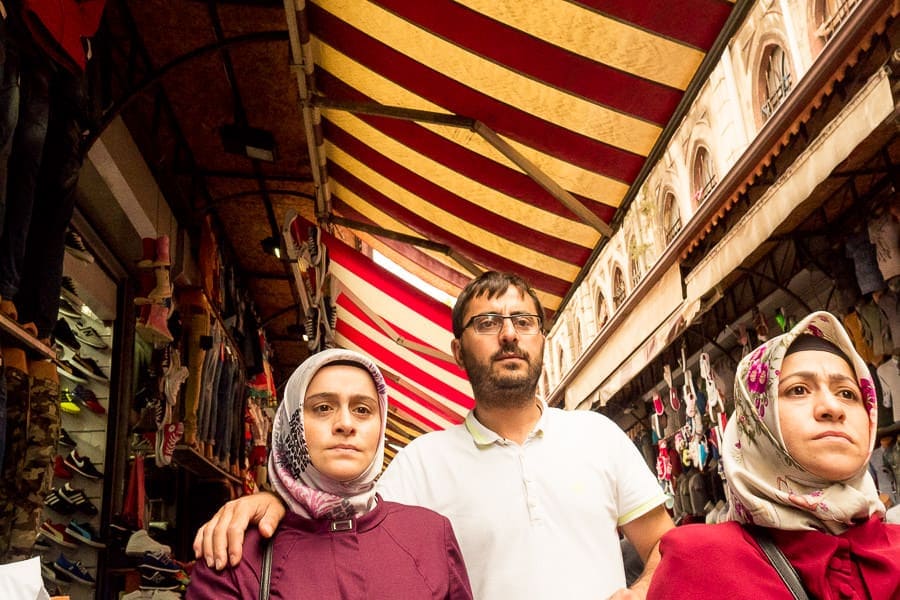
The focal point selection using the thumbpad is simple and intuitive (you don’t need to press the Up button to engage it – an annoyance of the Fuji X100S), but with Facial Recognition engaged, you don’t even need to touch the thumbpad – focus switches automatically to the subject’s face when you press the shutter button.
This makes it even easier to capture the subject’s face (unnoticed) during street photography. 
On small cameras, the fewer the number of button presses needed to take the photo, the better, and with helpful functions like Face Recognition on the Olympus OM-D E-M5 Mark ii, taking a photograph of a person is made so simple.
8. Speed
By this I mean, the number of photos the Olympus OM-D E-M5 Mark ii can take in a row in one second.
With silent shutter engaged, being able to shoot off a machine gun-like 10 frames per second without anyone knowing is a lot of fun!
Whilst spray and pray isn’t the aim here, the continuous auto-focus (the camera’s ability to focus continuously on a subject moving towards or away from you) on most mirrorless cameras is still leagues behind dSLRs. That’s one reason why being able to shoot off multiple frames vastly increases the chance of you getting the shot you want.
It’s also useful for shooting large groups of people, where inevitably someone will be blinking. With multiple frames per second, you will vastly increase the likelihood of getting one photo where everyone has their eyes open.
9. Stabilisation – Photos
The 5 axis stabilisation on the Olympus OM-D E-M5 Mark ii is truly remarkable, allowing you to handhold photos much slower than the reciprocal rule (the reciprocal rule means for example, if you’re using a 50mm lens, setting your shutter speed to any slower than 1/50 will most likely result in a blurry photo if you are hand holding the camera.)
In practice, what this means is that you’ve a way better chance of being able to take an unblurry shot in low light without using a tripod.
It’s the kind of feature that when you return to your trusty dSLR, you’ll wish it had the same thing built in.
Here’s a hand held shot at 1/15th second, which would be impossible with a dSLR:
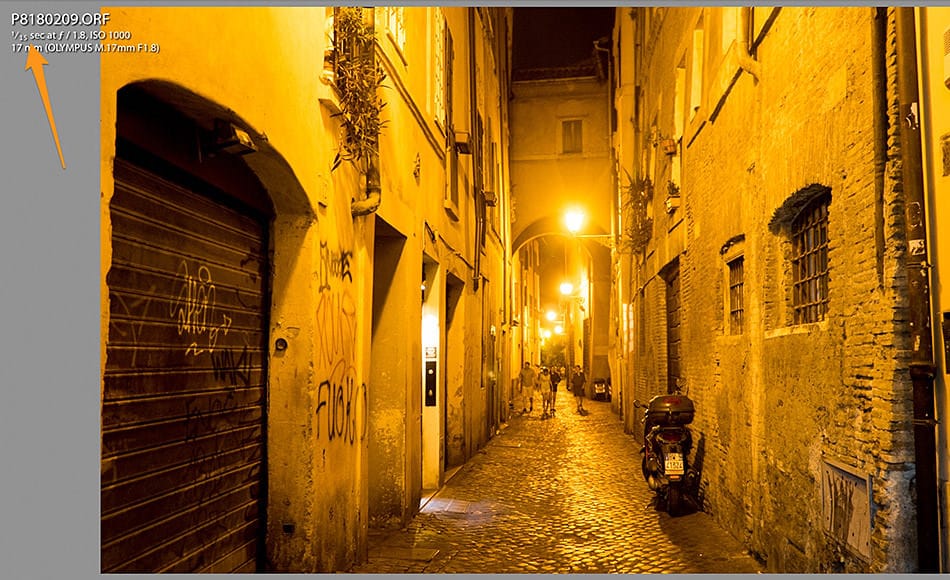
The photo stabilisation worked flawlessly for me, and I found it rather entertaining that whenever it was engaged, you could hear a tiny motor whirring inside the camera.
10. Stabilisation – Movies
Where the stabilisation really comes into its own is during the movie feature. It’s like having a built in steadicam, allowing you to produce movies with gliding movements rather than the usual jarring/bobbing recording typical of such a small cameras.
Looking at the LCD screen whilst recording and walking along is mind blowing – every step you take is muffled into a smooth motion right before your eyes, making you feel like you’re gliding.
Although I rarely ever shoot video on holidays, the stabilisation function on the Olympus OM-D E-M5 Mark ii made it so much fun (and the output so professional looking), that I found myself hitting the record button between shooting stills more and more often.
I’ll upload a movie to demonstrate this feature soon…
11. Live Exposure
This feature makes long exposure photography much, much easier and whole lot of fun too. Olympus refers to it as Live Time.
In a nutshell, Live Time allows you to see the exposure as the camera is creating it.
What this means in practice is that rather than simply guessing (or calculating) the exposure length required for a low light photo, you can start the exposure (i.e. press the shutter button), then watch on the LCD screen as the photo gradually changes, until the point where you feel happy with how it looks, at which point you can press the shutter button again to take the picture.
It really brings out the magic of photography and will no doubt remind photographers who use film of being in a dark room, watching their pictures come to life.

The Ponte Vecchio in Florence | 11 Second exposure @ f/8, ISO 200
It’s a bit like watching a Polaroid become a colour photograph in front of your eyes, except that you’re the one controlling how ‘bright’ the colours are – it’s a lot of fun!!
‘Bulb’ exposure on dSLRs allows you to choose the length of an exposure on the fly, but of course, during the exposure, you’re unable to see how it looks, so it still involves a lot of guesswork.
Using Live Time, long exposure photography techniques like Light Painting and Star Trails are made much easier, giving you a new level of precise visual control that’s simply not possible with dSLR cameras.
12. Megapixel Boost
This is a bit of a gimmick, but being able to take an 40 megapixel photo using a 16 megapixel compact camera is very cool in the right situation.
To be able to create a photo with so much data, the Olympus OM-D E-M5 Mark ii needs to stitch together a few photos, which means that the subject needs to be completely static for the length of the exposure. This means you’ll mostly be using it for landscape work on a very still day.
I’ll be honest – out of 5,000+ exposures, I only used this feature once, but I’m glad I did. It means that I can make a large print of the below shot of Athens for my wall and be able to see incredible detail.
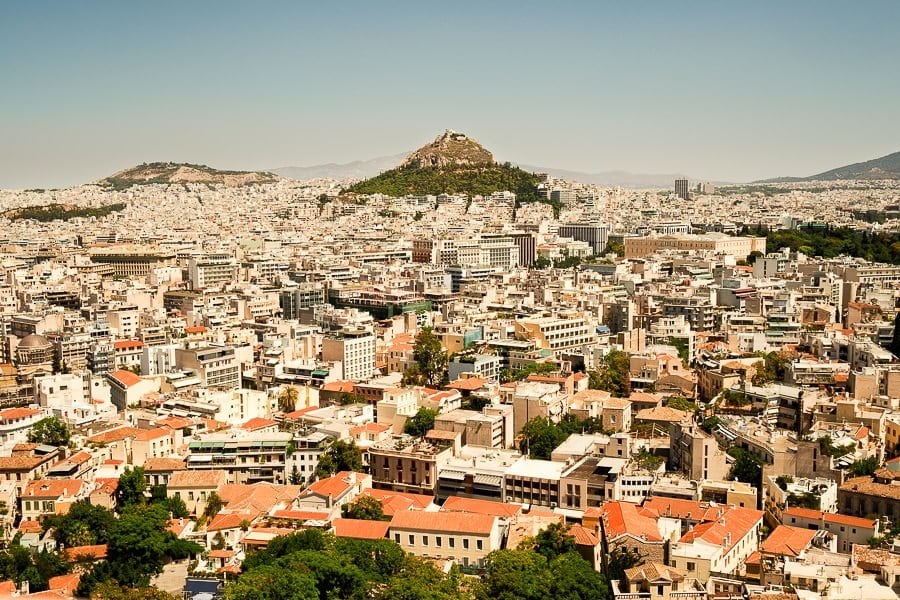
The size of this photo is 7296 x 4864, compared to 4608 x 3072 of the regular files.
Zooming in on the original image (especially on a Retina iMac!) is mind blowing. This screen shot doesn’t do it justice, but you get the idea.
![]()
13. Manual Focus
For those rare times when the Olympus OM-D E-M5 Mark ii struggles to achieve focus (usually in the dark), it’s great to be able to fall back on a manual focus system that’s executed in the best way I’ve ever seen on a camera.
If the camera starts struggling to focus, I’ll half press the shutter to disengage autofocus, then twist the ring on the Olympus 17mm f/1.8 lens I’m using. Immediately, Focus Peaking engages (and optionally a 100% zoomed image), that helps me be absolutely sure my subject is in focus.
For those of you who don’t know what Focus Peaking is, when you start to twist the focus ring on your lens, bright white lines start appearing around the edges of anything in focus. Keep turning the ring and the lines will move to other areas that are in focus, and when the lines appear around the thing you want to be in focus, press the shutter button completely and you’ve just got a shot in perfect focus.
Many compact cameras offer Focus Peaking as a feature, but the Olympus OM-D E-M5 Mark ii allows you to engage it faster and easier than anything else I’ve used.
When shooting wide open at f/1.8, I’d occasionally use manual focus to make sure I had my son’s eye in focus, or in the photo below, his eye lashes. Yes, it really is that accurate.

14. Dials
I love how the dials and shutter button placement on the Olympus OM-D E-M5 Mark ii mimic all Nikon dSLRs I’ve ever used.
On top of the camera, you have one two dials (wheels) – one controllable with your forefinger, the other with your thumb.
I set the front one to aperture and the rear to exposure compensation, since I shoot in Aperture Priority.
Using the LCD screen, it makes getting the exposure I want very easy – if the picture looks too dark, I roll the rear dial one way, too light the other way.
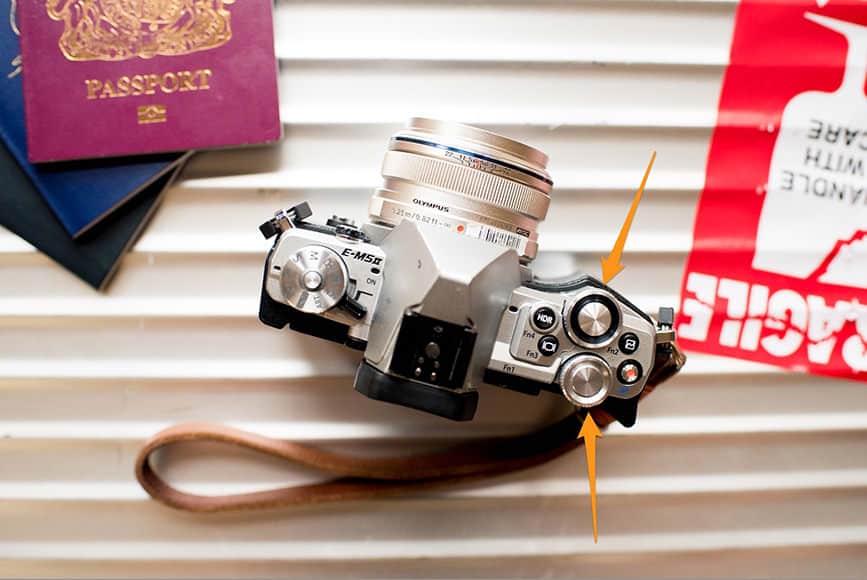
Even though this camera is small and the dials are very close to each other, the placement feels perfect and I can adjust both of them without moving my hand.
Even if you’re a Canon shooter, or more used to dials being placed elsewhere, the layout of the main dials/buttons on the Olympus OM-D E-M5 Mark ii is excellent and you’ll feel like you’re using a larger, professional camera body.
15. Grip
I’ve got big hands (24cm span). The grip on the Nikon Df for example is too small for me. My choice of Nikon over Canon initially was due to ergonomics alone. In short, how a camera feels in the hand is very important to me.
I can only fit 3 fingers and a thumb on the Olympus OM-D E-M5 Mark ii, which would normally rule it out, but due to one small addition, I feel comfortable using this camera and 100% confident that it will never slip out of my hand.
Perched at the top of the Olympus is a curved rubber thumb grip which protrudes out of the camera just enough to provide the perfect ‘ledge’ to support your thumb.
Coupled with a ridge on the front of the camera, I find it very comfortable and secure.

If you have gorilla sized hands, or you find it more comfortable to be able to rest all your fingers on the camera, there’s also an external screw-on grip available here which also includes an external mic input for video.
16. Looks
I think the Olympus OM-D E-M5 Mark ii looks great. I prefer the look of my Fujifilm X100s, but that’s at the detriment to its ergonomic functionality.
My preference is the Silver/Black body of the Olympus OM-D E-M5 Mark ii, and the black version of the Olympus M.Zuiko 17mm f/1.8 – available here.
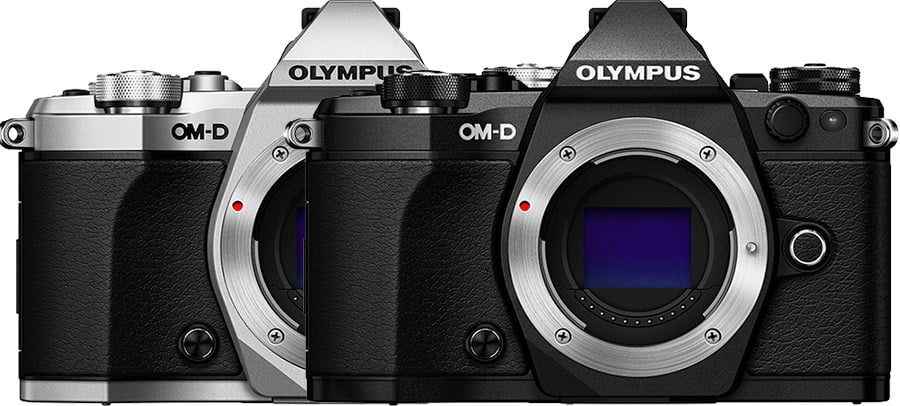
Olympus OM-D E-M5 Mark ii – What I didn’t like
Let’s face it. No camera is perfect. There are always going to be things we don’t like, and here’s the list of the things that pissed me off about the Olympus OM-D E-M5 Mark ii:
Menus
I’ve used the Olympus OM-D E-M5 Mark ii solidly for one month, shooting well over 5,000 exposures, but the menu still confuses the crap out of me.
Actually, I should say menuS, since there are several, all reachable by different buttons. It’s a bit of a joke really, and something Olympus should be working hard to sort out as their hardware is excellent.
Luckily, once you have your settings dialled in and saved, there’s not much need to go digging around in the menus each time. Also there’s the ability to save your settings, which proves invaluable if you need to reset the camera.
Auto ISO
I rely on auto ISO to save messing around with buttons when I should be capturing a moment. Auto ISO means that the camera will automatically adjust the ISO to ensure enough light is reaching the sensor, rather than slowing down your shutter.
Usually with an Auto ISO feature, the camera allows you to choose a minimum shutter speed, meaning that when the camera descends to that chosen shutter speed, it will start increasing the ISO to allow more light into your exposure.
However, with the Olympus OM-D E-M5 Mark ii, there’s no way to set this minimum shutter speed, meaning that instead of the Auto ISO increasing the ISO for you, it’ll drop the shutter speed first instead.
There is the excellent Image Stabilisation feature to help you achieve a sharp shot despite a slow shutter speed, but nevertheless, it’s a bit annoying when a camera of this quality which can comfortably shoot high ISOs should be favouring a higher ISO over a lower shutter speed.
There is apparently a workaround which involves setting a minimum flash sync speed, but I never got this to work.
Eye Sensor during Playback
Whilst viewing photos during playback, the EVF (viewfinder)’s sensor will activate if you hold your hand too close. What’s happening here is the viewfinder is optionally set up to detect your eye’s presence (i.e., when you want to look through the EVF rather than the LCD screen), but is actually just sensing any object that’s close, like your hand.
This means that whilst browsing my photos, I’d often set off the sensor by mistake, making the camera return to shooting mode.
This is a minor gripe, but nonetheless rather annoying and something I think could be fixed easily in a firmware update. All Olympus needs to do is deactivate the eye sensor during Playback.
Startup Time
As I’m predominantly a dSLR user, I’m used to a camera being ready to shoot the moment you switch it on. However, with MOST non dSLR cameras, this is not the case, in part, I assume, due to the fact that there are LCD screens to activate and other electronics.
The startup time on the Olympus OM-D E-M5 Mark ii is pretty slow, and can become annoying if you’re relying on it to get the shot.
My workaround was to keep the camera turned on constantly, and hold my thumb over the viewfinder sensor, thus deactivating the LCD and preserving battery life. When I wanted to take a pic, I’d just remove my thumb and snap snap, I’d be done.
External Buttons
In general, the button layout on the Olympus OM-D E-M5 Mark ii is fine. I’ve mentioned how I love the dials already, and the thumb pad for focus point selection is easy to use even with the camera to your eye.
What I don’t like is the fact that Olympus has chosen to devote prominent external buttons to what I consider to be useless features.
Useless feature #1 – HDR. Does anyone other than Trey Ratcliffe actually care about HDR anymore?! And even if you do, the iPhone shoots much nicer looking HDR than the Olympus, and can do it using a single exposure (rather than merging several, which is the proper way but means the subject needs to be completely static).
Useless feature #2 – Curves. Is there anyone out there who has ever chosen a curves adjustment before taking a photo?! I might be missing something, but why does this function even exist inside a camera? Curves should stay on your computer, not in your camera!
I should mention that these buttons can be remapped, but this involves digging into the convoluted menu, so I couldn’t be bothered.
Come on Olympus – make at least one of those buttons ISO and you’ll make a lot of pros happy! Or put an ISO button on the back of the camera, and remove those superfluous buttons altogether. Simple is better on small cameras after all.
Continuous Autofocus
It works… sometimes. This is an area most mirrorless cameras that use only Contract Detection struggle, so the Olympus OM-D E-M5 Mark ii isn’t the only one.
In simple terms, if a subject is moving fast towards the camera and you try and fire off 10 consecutive shots with the shutter button held down, the Continuous Auto Focus would be lucky to get 5 in focus, even in good light. This is where the Contrast + Phase Detection AF of a dSLR will always win.
I never shoot in Continuous AF though, so this wasn’t an issue for me, but it needs to be mentioned just so you know the limitations of the Auto-Focus on many mirrorless cameras.
Confusing Features
I’ll admit it – even after a month of playing, I couldn’t figure out how to use the Panorama function, nor set up the movie function so it did what I wanted it to. I didn’t understand a lot of the user manual either, but I never was very good with manuals!
Conclusion & Final Recommendations
Despite these small niggles, all in all, I love the Olympus OM-D E-M5 Mark ii and think you will too.
In my opinion, the Olympus OM-D E-M5 Mark ii is the best travel camera and best street photography available today.
If you’re a parent looking to buy a camera to take photos of your kids and want all the quality of a dSLR without the bulk, look no further – the Olympus OM-D E-M5 Mark ii is the camera for you.
If you’re a working pro like me and you want a smaller camera which has excellent image quality to ‘chuck in the bag’, this is it.

Take my advice and buy the Olympus 17mm f/1.8 with it, or get one of the excellent zooms if you’re feeling too lazy to zoom with your feet!
If your budget can’t stretch to the Olympus OM-D E-M5 Mark ii, I recommend you get its smaller brother, the Olympus OM-D EM-10 Mark II which has just been released. It has all the Olympus OM-D E-M5 Mark ii’s best features, all packed into a smaller body.
One final recommendation, buy a wrist strap such as this or this. Having a camera dangling around my neck annoys me and makes me look like a tourist, which is why I much prefer a wrist strap with a camera of this size.
Also, you do not need a camera bag! The whole point of having a small camera is that it’s there, ready to shoot at a second’s notice. Fumble around with velcro and clips and the moment’s gone. Trust me on this one!
One last option is to go with this Spider Holster, which, if you wear a belt and tuck your shirt into your trousers, is probably the best carrying system ever invented.
If you’ve read this far, thank you so much! I hope you enjoyed the review and the pics from my hols. Please leave a comment if you have any opinions about this camera, micro 4/3 cameras or anything you like :-)






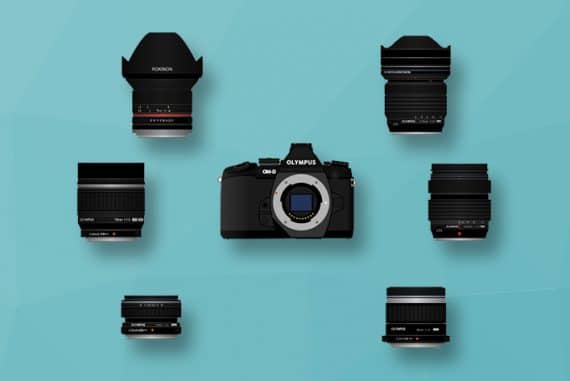
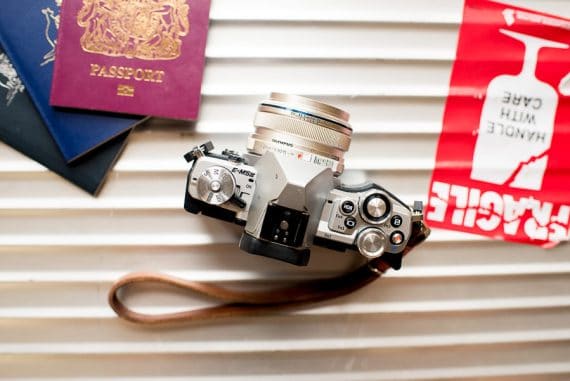
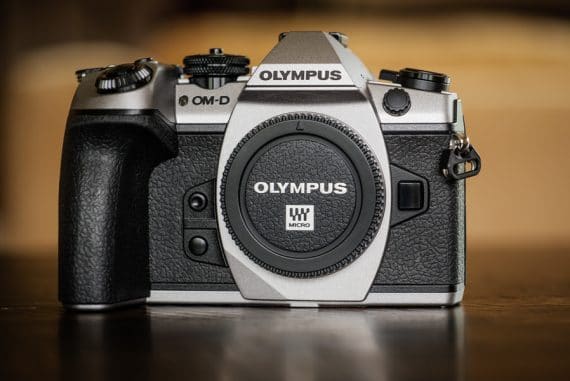
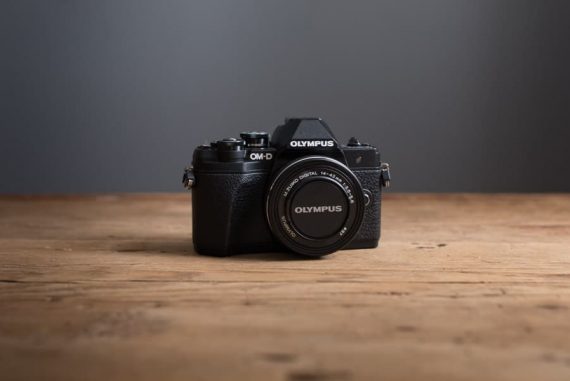
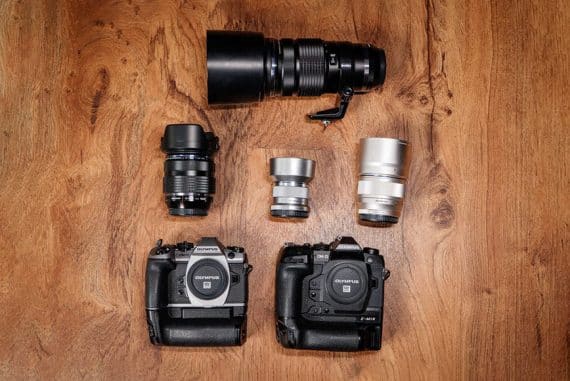




Thanks Mark for a great review. I bought the om d 5 mk2 because I was tired of carrying a heavy dslr. I have not regretted it. This is a great camera. You certainly can get lost in the menus sometimes but lots of good youtube videos to help get started. Love this camera.
Great review! Lot’s of wonderful information. A question for you. I have a 2014 A7 MKII. Would you trade it for the OM-D EM-5 MKII?
Thanks – Chris
Wonderful review! I have a Sony A7 MKII with the 28-70 mm kit lenses, the FE 24 – 140 telephoto lenses, and the HVL-F32M flash. I am considering trading it for the OM-D EM-5 MKII. Would you do this trade? If find that I don’t use my Sony that much, partly because of the size. I am an Olympus fan and have an OM-2n film camera that I bought new in 1977. What are your thoughts regarding me trading my Sony for the Olympus which you reviewed?
Many thanks, Chris
Hi, Mark: Based in part on the strength of your review, I purchased an OMD EM5 mark 2 a couple years ago. Like yourself, I sometimes hold my finger over the viewfinder so the camera is ready to shoot at a moment’s notice. However, this isn’t always practical and I’ve missed numerous photos waiting for the camera to wakeup. Is there a way to disable the sleep function even if at the expense of battery life?
Hi Yee-Ping! I’m not actually aware of a way to do that but maybe if you asked Olympus they could confirm. On most other cameras you can adjust the sleep time, so I imagine it’s possible.
Hi Mark, I have been tossing up about keeping my Cannon 700D or selling it to fund new lenses for my Olympus em5 mkii. Or selling both of my cameras and getting the em5 mkiii for 4K compatibility. After reading your article (great write up btw), I think I may lean towards selling my cannon to fund for the f1.8 lense you mentioned. My wife loves portrait photography with the bokeh effect and this lense meets that critieria. I am into video making recently. Will this lense work? And any recommendation for an affordable telephoto lense? Is it worth selling both my camera body to get a newer model that supports 4K shooting? Thanks in advance.
Hey Sheldon: 1. Yes it will 2. See this post https://shotkit.com/best-micro-four-thirds-lenses. 3. Depends if you need 4k to crop into your videos.
Hey Mark,
Really enjoyed this write up, thanks.
Can I ask which settings you use for your in camera JPG? The colours are very appealing, especially that shot of (presumably) your Son’s Grandfather holding your Son on a train/bus (with the clock above his head) and your (I think) wife to the left… that’s the look I like when editing my Raws from my cameras!
Can I also ask which focus modes you use when not using the tap to focus/expose/shoot modes and the face detect? I assume centrepoint focus and a quick flick of the wrist to recompose?
This review makes me want to pick up my girlfriend’s Oly e-m5 ii again. My experience with this camera is different to yours, I’ve used my girlfriend’s a few times but just didn’t like it. I also have a Panasonic G7, which is supposed to be the inferior m43 camera on paper but so far it performs better for me than the em5ii in my limited tests for what’s important to me (auto focus speed and accuracy in lowish light, and autofocus tracking, not face tracking just static object tracking).
One of the main things that frustrated me with the em5ii was sometimes, the actual photo would be a stop or two more underexposed than what was shown on the screen/viewfinder (one of the best features of mirrorless cameras is to “cheat” and be able to see the exposure before you shoot). After spending a while Googling I found the setting, changed it and it worked for a bit but then reset somehow. Maybe I’m a dumb dumb but my other mirrorless cameras don’t do this (beloved Fuji x70 and my Panasonic G7). I have a feeling it has something to do with underexposing with exposure compensation too much…
And the menus! aaarrr…… Talk about frustrating and confusing! I sort of gave up on this camera even though so many people talk about how good it is, I’ve yet to experience it. But I think I’ll have another red hot try at it thanks to you.
Cheers
Thanks Blake! 1. I think I just boosted contrast. Was a while ago, so can’t remember! 2. That’s correct – centrepoint/recompose! Great to hear your experience with the M43 cameras. Definitely give this one a try and lmk how you get on. Cheers
Thanks for the reply Mark.
Hi Mark,
great article – very informative. I am moving up from an olympus epl3 which has been a great little camera. Used with 14-42mm and a 45mm portrait lens. I’m considering either the m5 mk2 or the m10 mk3. Both are hovering round the same price now and wondered if you consider one better than the other?
Cheers,
Derek
Thanks Derek. I’d recommend holding each camera if possible, to see which suits your hand size. I love the M10 but find it a little small, so prefer this camera here in the review.
Hello Mark, I’m thinking of buying an m5 mkII with the kit 12-40 f2,8 taking advantage of current prices.
Could you tell me if you find heavy or unbalanced the combo?
In the forums I have read that many people complain about this and I have no chance to see it personally, before the purchase.
Thank you
Alfonso
Hi Alfonso – with bodies of this size, any zoom lens can feel a little unbalanced, but this is just the trade-off of having something so compact. With longer/heavier lenses, it’s normal to support it with one hand, and the camera with the other, so I don’t really see it to be a big issue. All the best!
Hi Mark,
Enjoyed your review of the Om-D M5 as I am looking for a camera which is suitable as a travel camera & this seems idea. I have been looking at the OM-D M5 11 or pssibly an Olympus OM-D M10 II or M10 111 as they are a little cheaper & would appreciate your cooments and advice on the different models & which is best in your opinion. They all seem to have similar features, however I assume thatbthe M5 is an upgrade to the M10 & I think it may be more weatherproof.
I was considering the Sony A6400 or the A6000 however the Olympus appears to me to be better and simpler plus the lenses appear to be smaller, lighter & cheaper.
Any comments or advice would be greatly appreciated. Enjoy reading your various articles and reviews.
Regards
David
Hi David! All the cameras you’ve mentioned are excellent, but if weather-proofing is important to you, get the M5. And yes, the MFT lenses are smaller, lighter and cheaper, so if that’s a big consideration, skip the Sony bodies. Does that help?
Hi Mark, thanks for your reply & it does help with making my decision. I think the weather-proofing and lens sizes/prices are all worthwhile. This little camera feels & is smaller than either of the Sony cameras I mentioned so I think its more suitable for my needs like street and travel photography. Now the hard decision is whether I prefer the Silver or Black model & which lenses?
aha yes, the colour decision is a tough one! All the best, David.
Thank you very much for the great review, Mark. I am in love with the OM-D EM-5 concept and am looking at picking up a mark in on sale now that the mark iii is out. What I worry about though is the impact of the 4/3 on image composition. I’m used to APS-C aspect ratio from my Nikon D5000 and Canon PS G12. Did you have to crop all the pictures in your review as they don’t look like the more square 4/3 ratio? And does your comparison with the Nikon image where you captured the dock you were standing on indicate a real trade-off in terms of composition for wider-angle shots (I notice that the Olympus shot also loses some landscape and nicely lit sky on the right)? Your thoughts on this would be much appreciated.
Seb
Hi Seb, thanks for the kind words! I prefer to set M4/3 cameras to shoot in 3:2 ratio, as that’s what I’m used to composing with. This crops the image in camera, but depending on the camera/editing software you use, you can usually choose the original 4:3 image after the fact. It’s not a big trade off, and I think you’ll get used to it quickly (especially since most smartphones shoot in this ratio too). I hope that helps?
Thank you so much for the insight, Len! That’s super helpful. Btw. Love the photos in your review too. Great colours and perspectives, esp. the candid people shots.
Thank you, Mark! Really appreciate your insights and response … as well as the beautiful pictures in this review. Love the candid people shots in particular.
Thanks so much, Seb! All the best.
Hi Mark,
Thank you again for your advice. I’ve been shooting my OM-D for about 3 months now and I’m loving it. Picked up a new body w/o kit lens and spent the money on used 12-40 mm pros and 17mms instead. Love both lenses because they allow me to shoot the camera more like an SLR with the bigger lens and like a pocket camera with the 17mm. Both produce fantastic results. I’m particularly impressed with the colour rendition. With my old Nikon (D5000), I always had to adjust the white balance in post-production (especially because it robbed the coastal forests where I live of their lush green and blue tones). The OM-D delivers amazing colours even in raw format. Struggling a bit with the sluggish turn-on time and focus – but then again, it’s not a camera designed for wildlife and sports. Most importantly, I have it with me all the time – clipped to my shoulder strap while shredding powder or tucked in a pocket while strolling the city – and I’ve gotten photos from places and situations to which I would have never thought to bring my SLR.
Thanks again and keep up the good work :)
Thanks for the feedback, Seb – interesting to hear about your results.
Really liked your review! I’ve had an Em5 ii for a few months and i love it but agree with you on the niggles. The video could have been done much better too.
“There is the excellent Image Stabilisation feature to help you achieve a sharp shot despite a slow shutter speed, but nevertheless, it’s a bit annoying when a camera of this quality which can comfortably shoot high ISOs should be favouring a higher ISO over a lower shutter speed.”
Great review, but the above statement confused me. Don’t you mean the opposite? It’s sounds like the camera is, in fact, favoring a lower shutter speed over a higher ISO despite the fact it can perform reasonably well at higher ISOs.
Hey Len, I agree it’s confusing, but what I’ve written there is in fact what I mean. I wrote that review some time ago, but I think I was referring to the fact the camera can handle slower shutter speeds (due to the IS), but when in a semi-automatic mode, the camera chooses to raise the ISO to achieve the correct exposure, rather than slowing down the ss. With its small MFT sensor, it can struggle at higher ISOs. Does that make more sense?
Thanks Mark for this great article/review. Would just like your advice as I am about to go on a similar month long family trip to Europe ( Italy, France, Portugal and UK ) and coming from A7R2 with big lenses I was very wary of having to carry any sort of heavy kit .
I went and purchased the EM52 and the 17/1.8 as you suggested in the article .
Street photography and architecture high on the interest list .
I love the idea of light weight no lens changing etc .
My real question is would I gain by also taking the 12-40/2.8 ?
Pretty sure you might say zoom with my feet ?
Thanks for any help
Haha yes, zooming with your feet is sound advice, but I do understand the important of a zoom too, especially when traveling when moving physically closer to a subject may not be possible. If this is the lens you’re talking about, it looks like it’d pair well with your camera – not too heavy, despite being a fast lens for a zoom. If you have the budget, I think that combined with your 17.18 (for low light), it’d be a wise choice. Enjoy your trip!
Appreciate the wisdom . Yes thats the lens I am considering . Nice to have you confirm my thoughts especially the 17/1.8 for low light . See you round the traps . Cheers .
Nice review. I didn’t know about touch-n-shoot. Fast to enable/off right from the camera’s shooting screen. Been checking it out. It’s fast and nails it. I use back button focus, which is a little slower and fiddlier. I like it for most of my shooting. Seems I’m finding something new or another way of doing something with the M5 II.
I have the 12-40 f2.8 pro its an exceptional lens, but such a beast. I picked up a Panasonic 12-32mm f3.5-5.6 for a $100 bucks. It is so small and with OIS its great for video. It is sharp enough and it’s not a ‘thief magnet.’ Another bargain lens is the Olympus 40-150mm f4-5.6, got a new one for $60! This one will surprise you and it’s small and light. Also makes a good macro lens with extension tubes.
I like to do time-laps. But the weak battery kills it for longer shoots. I had a battery die soooo I took it apart and am making ‘dummy’ battery out of it. Hook it up to a NP-F770 5000mAh or a NP-F970 7900mAh. So now I’m off to the races.
Thank again for your review.
Thanks Douglas – nice to hear about your experience too. Glad to hear your worked out a solution to the battery issue!
I bought the om de5 mk2 18 months ago and love love love it! I am still discovering features on this camera I was previously unaware of. As I love getting outdoors weight and weatherproof were two factors that appealed. I am very much an amateur and am keen to try night photography so purchased M.Zuiko 17mm f1.8 on recommendation – price was also a big factor. Its a great wee lens and is my go to if I am out for the day and decide to chuck my camera in my bag.
Have you tried this lens at all?
Hey Carolyn, yes it’s a great lens and the one I recommend right here in this review ;-)
First – thanks for the great reviews. I’ve thoroughly enjoyed reading them.
My question is tied to the OM-D E M5 II vs the Fuji XT-20.
I currently have a Canon 60D and have made a couple of Europe trips with a 18-135mm lens. Pictures have been fine but it is a “luggable”. So I started looking around. A friend uses the Fuji and loves it. At a local camera store I’ve played with both models and each have decent feel and features. What I’m stuck on: The M5 (though old) currently has a deal with a 14-150mm (28-300 effective) that has strong appeal as a one lens only travel lens. A comparable lens on the Fuji would cost much more not to mention it is larger and heavier than the micro 4/3. At least 25-30% of the pictures I’ve taken exceed the 50mm range.
However, almost every picture I’ve seen from the Fuji seems to have excellent image quality and color on the jpeg renders. I can’t say the same for the M5 but am somewhat at the mercy of the posted pictures on the internet. Because you’ve shot both can you comment on whether you feel there are measurable/visible differences? I do some post processing but less is more 🙂. Most of the other attributes (for me) seem to favor the M5 (especially cost when equipped with zoom lenses) but the image quality is a big one. My most important attributes are focus speed/accuracy and image quality. I would appreciate any insights you can offer.
Hey Lucy, I have to say I prefer the image quality out of this Fuji better than this camera. Also the way it handles high ISO is better too. As for focus speed/accuracy, the Olympus is better… so it’s swings and roundabouts! Have you got any other specific questions?
Not really. I was hoping for some clear distinction to make one a better choice but it does appear to be a toss up. If you could pick only one, would you go with the Fuji? I may also hang on to see if the long rumored M5 III has improved anything.
Yes, I’d probably go for the Fuji for that slight advantage in image quality, especially at high ISOs. And yes, a M5 III will no doubt be coming soon, but it’s very likely to have the same M4/3 sensor… so the Fuji will still beat it at high ISO.
I know this is a very late comment, but as a new “real” camera user for outdoor use, would it be best to stick with the E-M10 Mark III and learn, or just stick with the weather sealing of the E-M5 Mark II? I’m concerned the menu confusions will inhibit my learning curve, especially as I like to spend time shooting over changing settings. However, I only shoot during hiking and canoeing, so the weather sealing is attractive. Thoughts?
For canoeing and activities that involve splashes, you’d obviously be better off with the weather sealing. No matter how complex menus are, if you use the same camera often, it becomes second nature – the start is just more of a pain to get used to it. Hope that helps!
Thanks Mark! I really plan to mostly shout on the Auto and Scene modes (maybe A mode during landscape). I just love the out of camera image quality coming from these things! Decisions, decisions!
HI Mark, and everyone. This is the perfect review despite the fact it has me more confused than ever. I believe you reviewed the Fuji Xt20 as well and gave it to a stellar review. I know it came after the Oly 5 M2. So, out of these two, which one would you vouch for? Thanks
Hey Pearl, sorry to confuse you! If you shoot a lot of low light photography (without flash), the Fuji wins due to its slightly larger sensor and better ability to handle higher ISOs. The lens selection is also better IMO (see: https://shotkit.com/best-fuji-lenses/ and https://shotkit.com/best-micro-four-thirds-lenses/) On the other hand, the Oly has faster AF, and the touch to shoot function is incredible. As a final test, I’d recommend holding both of them to see which feels the best in your hands. They’re both excellent cameras, so you can’t really go wrong with either.
Dear Mark, thanks so much for the great review – I’ve just spent an hour browsing through several of your posts, for I’ve been very confused as of which mirrorless camera I should get. Right now I’m quite confident that I’ll go for the Olympus OMD EM-10 series, probably a Mark III. I’ve been considering the Fuji X-T20 too, but it’s a tad more expensive. Which one do you think is more suitable for street/travel photography? I’m a freelance writer who loves to shoot when traveling, but also to snap daily discoveries while I’m out and about. Thanks much and keep up the good work!
Hi Claudia! Either of those cameras would be a great choice. I’d edge towards the Fujifilm since the image quality at higher ISOs is slightly better, but I’d recommend you hold each camera first too to see which one fits your hands the best. They’d both be excellent for travel/street photography, so don’t worry about making a ‘wrong’ decision! Good luck
Thanks for your feedback, Mark! Good idea, I’ll make sure I hold them both to see how they feel before making any final decision (:
FYI, you can easily change the ISO quickly – flip the lever beside the viewfinder down and now the rollers control ISO and white balance instead of aperture and shutter speed. I also set the button on that lever for back-button focusing so I can pre-focus without half-pressing the shutter button. I find it was worth sitting down for an hour and going through all the menus and assigning options you use to buttons you don’t, since pretty much every button on the camera can be re-assigned if you want. I’ve had this camera for a couple years now and ADORE it. It’s also durable, mine’s all scratched up and a wave came over it at the beach last year, but since it’s weatherproof (as was the lens I had on it at the time) it survived just fine!
Ah great tip Amy! Thanks for sharing :-) It always interests me how many people read reviews -after- they’ve bought cameras – I do the same! It’s nice to have reassurance that you’ve made the right decision ;-)
Thanks, I do occasionally read through reviews afterward – since everyone uses cameras a little differently sometimes I find things I didn’t know the camera could do! And since they sometimes make updates in firmware (I think the most recent one adds focus stacking) it’s worth taking another look now and then.
This post is so great, Mark! I have an OM-D EM5 MII and bought it about a year ago, but am just an amateur so reading this post has given me an insight into the camera’s features that I didn’t even know about! Very cool.
I got it with the 12-50mm f/3.5 lens (came as a kit) and am definitely ready to upgrade my lens now (urgh the lowlight capabilities on the 12-50 are so bad). Tossing up between the 17mm f/1.8 prime you used here, or the 12-40mm f/2.8 which a lot of photography reviews seem to recommend. What are your thoughts? I mostly use my camera for travel and love street photography when travelling, but also spend a lot of time in the outdoors so appreciate the flexibility in zoom which is doable with the 12-40mm…
Thanks Lauren! From what I’ve read about it, the 12-40mm sounds like a great lens. I can’t remember having actually shot with it though so can’t comment other than that, but if you need a zoom, this seems like a sensible/useful focal length. If you don’t need a zoom, the 17mm is the way to go!! All the best!
Great review Mark. I have one which I’ve had now for around 2 years, but just couldn’t resist supporting your article. I have a few lenses, but the 40-150 f2.8 is amazing and with the 1.4 teleconverter, even moreso. Someone mentioned the 9-18 which I also have and again, a great lens. I also have the 12-40 f2.8 which is my ‘default lens’ and 45mm which was a ‘free gift with purchase’ from Olympus and which I have never used – spoilt for choice!
One way I improved the quality of my shots were changes to a couple of simple settings – set image quality to ‘L-SF’ in the camera – you don’t get as many shots, but the quality improvement is remarkable. The other one is to select ‘Don’t Resize’ in any photo sharing sites you post them to (I use Flickr and you can change this in settings).
I only shoot jpegs – tried RAW, but LR and I are not good friends. I use Snapseed and editing takes me around a minute.
Anyway, I thought your article was great – makes me feel like I made the right choice!
Hey John, haha that’s great! Yeah you certainly did make the right choice. Despite newer models released each year from various manufacturers, cameras like this one will stand the test of time as great all-rounders. The size of the MFT system is just so good for traveling too, as you know. You may also like this post https://shotkit.com/best-micro-four-thirds-lenses/ (but it sounds like you already have quite the collection!!)
This review was very helpful! I’ve been thinking of getting this camera for some time now. While in school I always used a Nikon D800 with a zoom lens for all my photography/video assignments. Now that I’m out I just accepted my first full time position as a communications specialist at a school district. There I will be covering a lot of school events and sharing the stories that happen within the school. I’ll be capturing photos in the classroom and videos of student activities. Would you recommend this camera? I would also like to use it for travel purposes. Just looking for a good all around reliable camera that doesn’t have too much bulk!
Hi Emily, yes sure – it’d be great for in the classroom and for travel. The micro four third sensor cameras are the perfect size if you don’t want too much bulk. This post should help you too when you come to lens selection: https://shotkit.com/best-micro-four-thirds-lenses/
Awesome review Mark! I have been thinking about this camera for a while now and past few days I got really excited as they have it on sale here at the moment in AU but I need to act fast as sale ends TODAY. Your REAL WORLD review helped me a lot to make my decision and inspired me a lot too. Thank you.
Ah lucky you, Simeon! Jump on it quick!
thats my favorite camera ever i have, very very love omd em5 mark ii ❤️❤️❤️
Hi Mark,
Thanks:) Yeah i figured that- but do I need to get any lenses at all to start? Or I have to buy an additional one right away? My apologies- I just didnt know if the body was just that or if I could use it as is- Im new to this!
Thanks again
No problem Meredith. If you buy the ‘body’ it won’t come with a lens, so yes, you need a lens to take photos. Most googd cameras come as just the body, to allow the purchaser more flexibility in choosing exactly the lens they need. Hope that makes sense?
Awesome review mate. Late comment i know.
But im stuck deciding between this camera or the fuji xt2 at the moment they are the same price. So either the omd em5markii or the fuji xt2? I can’t decide ive handled both but still confused. It will be manly for street photography an low light/night street photography.
Thanks mark
Thanks Mark! As good as this camera is, I’d have to say the XT-2 just pips it if you need something for low light street photography, mostly due to the bigger sensor. The AF is faster on the OM-D, but it’s still great on the XT-2. So I’d be getting this body and this lens if I were you. That would make for one solid street photography combo – just remember to get nice and close to your subjects for impact! Does that help?
Hi Mark,
I am getting really excited about this camera but do I really have to run out and get an additional lens with it? Is the camera OK as is for a while until I figure out what I really need? I mainly take pics of my kids, travel pics and an upcoming trip to Norway to see the Northern Lights. Let me know your thoughts. Oh and this article was amazing:)
Meredith
Hi Mererith, thanks for the kind words about the review – I’m glad it helped. It’s hard to find the Olympus with a bundled ‘kit’ lens, so yes, you’ll need to invest in one when you purchase the body. All the best on your trip to Norway – the live view long exposure feature on this camera will be perfect for capturing the Northern Lights!
Hi Mark, great article on the Olympus. I purchased a reconditioned unit directly from Olympus when they were offering 20% off. I also purchased the 9-18 Micro 4/3 lens after reading a few reviews as I hike and wanted a wide angle lens. Anyhow I used the lens at Sams Point in NY and wasn’t overly impressed with the results and I am wondering if its just a learning curve or if I would have been better off with the 17 mm 1.8 lens. What are your thoughts on the 9-18? Maybe I just need to spend more time and figure out which settings work. It was a bright sunny day so its possible I need to also purchase the lens hood which I was surprised it didn’t come with one for the cost of that lens.
Wow, 20% is a great deal Damon! Hmm well I’d always recommend a prime lens over a zoom. I haven’t handled the 9-18 before, but I’m guessing that if you weren’t impressed with the results, it’s a little soft. Stick it on ebay and save up for the 17mm ;-)
In my local retail shop – the om m5 mark ii camera is bundled with a kit lens around 15 to 150mm – I have never owned a camera with detachable lens before – is this worse off than getting two separate lens with different ranges? I am kind of attracted to the idea of just having a single lens.
Regarding 40mp option, is this difficult to set up and use in reality, or is it ok once I can locate the option from the menu?
For star trail, someone told me some.lens are not built to take pics of stars and will be damaged in long exposure – is this right and can om camera do it?
Thanks
Maria
Hi Maria, to answer your questions: 1. One lens is more convenient, but 2 prime lenses (fixed focal length) can give you other creative options and usually the ability to shoot in lower light. 2. Yes it’s easy to use and set up as long as you steady the camera completely. 3. No it’s not true and yes the camera can do it, whatever the lens. Hope that helps!
Hi there! I’m planning to buy the cheaper Olympus OM-D EM-10 Mark II because I’m on a budget and would rather buy a lens with the extra money I’ll save. I have no idea about cameras so your post really helps. One thing I’d like to know, do the lenses you mentioned here also work well with the EM10 like it did with the EM5? I’m interested in the Olympus M.Zuiko 17mm f1.8 since you’re recommending it so much. Thanks!
Yes they do, Vi! I also owned the EM-10 Mark II and it’s a great camera with very similar image quality.
Oh, exactly what I needed. Thank you so much for this review, Mark!
I’ve wanted to move away from simple point-and-shoots (mostly my phone) for a long time now, and I feel ready for the jump. For the past few weeks, I’ve tried to learn some basics about cameras and lenses to be able to make a good decision. The “problem” for me is always that I need to fall in love with bigger purchases for me to really want to use them (example: my car), so recommendations don’t work too well, but if I can discover an option myself, chances are my eyes will start to glow.
I considered different cameras, too many of them. The more I learned, the more confused I got about what I really need and want. I was ready to give up for now when I stumbled on the Olympus, and thought, “This could be the ONE.”
(Wow, this really sounds dramatic, but I’m seriously passionate when it comes to these things …)
Long story short: I wanted to know what professionals think about this camera, so I checked for sample images and videos and reviews, and then I stumbled across this …
Again, thank you! I really, really appreciate it.
Ah great, I’m glad you found it useful Stef. I intend to write more reviews on cameras meant for amateurs or enthusiasts, but used by pros. The Olympus is definitely one of the better ones.
Great write-up, Mark! This is one of the most useful reviews I’ve seen for the E-M5 Mk II. I love your straightforward, no-nonsense style. I own the original E-M5, so I can appreciate all your pros and cons. I have a couple of comments to make though:
– That 4-stop underexposure comparison against your Nikon was an eye opener. And correction: the Olympus’ sensor is only 1/4 that of the Nikon’s –not 1/2! That makes it even more amazing!
– I’m not sure if they’ve tweaked the grip of the Mk II vs the Mk I, but I find it hard to get a good grip on my Mk I model, and I have mid-to-small hands. I find the grip on my old E-P1 is better! That’s why I always have my HLD6 grip attached.
Hey Carl, thanks for the kind words. And yes, I stand corrected – you’re quite right about the sensor size! Full frame vs Micros 4/3 indeed. Great to have your feedback!
Hi Mark, Thank you for an excellent review. I found it very helpful and constructive. Nevertheless, I would like to add a comment about Auto Iso – my apologies if you have covered it somewhere and I missed it! You say that it is not possible to set minimum shutter speed. Strictly speaking you are right but it is possible to limit the range of ISO. If you set the maximum ISO to your choice, say 1600. With reduced light the camera then will use slower shutter speeds rather than push the ISO further. This makes best possible use of the excellent OLY stabilisation in low light. In order to set ISO range – use Gear Menu E and adjust “ISO Auto Set”. Hope that helps?
Hey Rob, yep you’re absolutely right! I’d much prefer to set a minimum shutter speed usually, but with the stabilisation, it does help a lot!
Really excellent review, thank you. However I hope I’m coming across as a pedant nit picker, but you should correct a couple of mistakes, I’m only pointing them out because they really stand out in such a good piece of writing!
Rome is not in Tuscany (one n, not two) but in the region of Lazio. And the duomo is in Milan, not Rome.
I hope you don’t mind, and thanks for the excellent work
Oh thanks Mila! Silly me! I’ll correct those errors :-)
“Unless you’re a pro or a serious hobbyist, don’t waste your time with a dSLR” ???? Ummm, the E-M5ii is far from an entry level camera. It’s actually considered as a pro level. The E-M5ii has a long list of pro users from wedding photographers, travel photographers, and National Geographic photographers. I do suggest to anyone that has the E-M5ii to spend the money on the full battery grip. This makes a huge difference in usability of the camera. Plus you gain a few more programmable buttons.
Hi Mark!
I’ve recently decided to make my first “real camera” purchase, and have been scrolling the internet tirelessly trying to decide what’s right for me…which led me to this review! Very helpful, thank you!
I’m looking for a quality camera with a vintage body, good for travel and everyday thats simplistic… and well suited for an amateur. I had been interested in the Fuijifilm x series until I read this review! Now I feel kind of lost… Do you have any suggestions on a make/model that might be a good fit for me?
Any insight is appreciated!
Kind regards,
Kari
Hi Kari! There are so many variables when it comes to choosing a camera and without knowing more about those, it’s hard to make a specific recommendation. However what I will say is that this camera is better if you need fast autofocus (for kids running around etc.), and the similarly price Fuji models have better image quality – but only another photographer would likely be able to notice!
Hi there!
So glad I ran across this review! I am an Olympus (PenMini) owner and user for 6 years, sadly I dropped it and have to make a decision to spend money on it to fix it or upgrade to a new camera.
In short-er ;) I am not a pro by any means. Just a mom who takes thousands of photos (as well as avid Scrapbooker) and has become surprisingly good at capturing moments. I am not great with all the technical jargon. I’d like to start doing lifestyle family photography. (Not pro but to offer families/couples nice photos, capture their lives and memories for them). So to upgrade, in your opinion, would going to this camera or the Sony a6300 be enough? Or should I not waste my time and money and start learning about an actual dslr? One big annoyance about my photos I’ve taken is I do notice I lose some of the sharpness and image quality of I do any editing in Lightroom. I want to improve that aspect. i would so appreciate any feedback :) Meg from Alberta!
Hey Meagan! If you were looking for a camera to keep up with your kids, I’d definitely recommend this one. However for professional lifestyle work, I’d recommend investing in a dSLR. I assume you’ll be working mostly during the day, so things like high ISO performance won’t be so relevant to you, meaning you may be able to save a lot of money buying a crop sensor camera rather than full frame. How about starting with one of the dSLRs on this list: https://shotkit.com/best-cameras-500/ Let me know if you need any further advice!
Hi, I’m considering the em5 mk 2 or em10mk2 or Em1 for using with the new leica 100 to 400 lens. Want a lightweight set up for wildlife/bird photography including some birds in flight so continuous auto focus needs to be good. Which Olympus body will give me the best results with this lens?
Hi Stephen, I haven’t used those cameras with the Leica so can’t comment I’m afraid. However, that’s a big zoom, so I’d be going for the biggest camera body to offset the size/weight if I were you. Hope that helps!
Hi Mark,
Fantastic detailed review! I am thinking of using this camera with the high resolution setting for landscape photos that I like to print onto large (40″ × 60″) aluminum. Do you think this camera is suitable for this task?
I do admire the IQ of the Fuji cameras and would you recommend them for the type of work that I like to do?
Cheers,
Bill
Hey Bill, glad you liked the review. Yes, 40 x 60″ sounds doable – just be sure to keep the camera as steady as possible and use a low ISO and high shutter speed. Fuji has better IQ as the sensor is bigger/better than MFT, but it’s swings and roundabouts. Go with the one that feels best in your hand. Good luck!
Hi Mark, I like your review and pictures. I sold E-P5 and now I got E-M5ii. I use the same 17mm f1.8 lens for my new E-M5ii. Not sure whether it’s due to different processor and sensor, but the pictures from E-M5ii are not as pleasing (or natural) as those from E-P5. The problem with E-M5ii is that colors (especially with red and blue) are too rich and dense even with the lowest settings for saturation and contrast with muted or portrait picture modes. No problem with video flat picture mode. You pictures look so natural and love the color rendering. I’m curios what kind of setting you have with your E-M5ii. I usually shoot at P mode. Please share your settings and tips with E-M5ii. Thanks!
Hi Jung! Thanks for the kind words. I shoot in Aperture priority, almost always wide open at f/1.8. I shoot in RAW, but occasionally when using JPEG, I don’t change any of the settings regarding how the file is processed by the camera. Maybe try shooting in RAW and applying a basic preset on import via LR and see how you go! Good luck!
Well, if there was something I noticed immediately, then it was the unreal appearance of these pictures. And I used to have the same problem with my E-M5 mkI when I changed from Panasonic GF2. Pictures from my Pana GF2 looked much more realistic, and I was unable to create realistic look of my E-M5 pics, no matter OOC or Raw. Pics have this strange ‘comic-book’-like appearance. Not to my taste at all.
Great review. Thanks. I wonder how much bigger the whole system would be if it employed APS-C? If only the sensor was a little bigger this camera would be spot on for what I am after. I am looking to get my first serious camera. D7200 is main competition as research has led me to believe;
* D7200 would have clearly superior IQ
* Continuous AF for shooting sports and moving kids much better on D7200
* Low light performance much better on D7200
* Same ballpark price as OMD5 MkII
These 4 factors are important to me, particularly IQ.
I think the OMD wins in all other areas. It’s weatherproofing, size and ability to be used inconspicuously are huge advantages over the D7200.
My ultimate goal is pro/enthusiast photography (give me 2 – 3 years). I realise that requires at least a D750 or say A7II in mirrorless (or A7RII). I won’t spend that until I know more.
So whaddya reckon? D7200 or OMD 5 MkII for me? Maybe another suggestion. Cheers :)
Hey Andrew. It’s a bit of a hard comparison since they’re entirely different cameras. To narrow down the variables, just think 1. – do I need a small camera? If yes, the OMD. 2. Do I need the best IQ – if yes, D7200. Good luck!
I’ve been on the fence for a while now about purchasing a smaller compact camera solution. Your review has helped me with my decision. So I’ve ordered the E5 mkii with the 17mm 1.8 and 45mm 1.8 lenses
I have two full frame body’s and a number of primes for my wedding work but I have two toddlers and wanted a camera that takes good pictures and has the function of dslr but without the size & like you said I can never be bothered to lug my dslr and lenes around when we’re just out and about the kids.
Hope I’m not disappointed still waiting for it to arrive :)
ahh I feel the pressure now Graeme :p I’m sure you won’t be disappointed. If your toddlers are anything like mine, you’ll need a camera with fast AF like the Olympus!! Good luck!
Thanks for the quick reply, Mark!
Would I be correct to interpret your comment as, even though Fuji has a bigger sensor for better picture quality and colour, but with Olympus’s higher class AF + its IBIS for image sharpness, you have chosen the Olympus, because you can always adjust colour in post production to produce the same image quality?
If I was to also add in the fact that, in Australia at the moment, Fuji is have a $200 cash back promotion, which has made the price of a Fuji X-T10 + 16-50mm to be about $850, whereas the Olympus EM5II + 12-50mm is at $1,280. Would your decision be changed?
Many thanks!
Hi Mark, thanks for the nice detailed review! I am an amateur photographer, who is planning on moving from a point and shoot / smartphones to a decent camera. I mainly do landscape photos and portrait photos as my wife and I are travelling at the moment, we would also do some ‘selfies’ and street photos. We maybe doing some videos in the future. So, in short, we are looking for a daily all rounder camera.
I’d like your opinions if you were to choose between the Olympus E-M5 II vs Sony A6300? As I have been torn between them, and cannot decide which to go for. Many thanks!
Thanks Ian! The Sony has legions of fans but I prefer the Olympus purely down to how it feels in my hands. I’d say pick both up and go for the one that fits yours the best.
Hey Mark, We actually went into a shop to feel and played for a bit. We have came across another dilemma!
There were 2 different shops that have recommended us the Fuji X-T10 to be considered. Now my wife and I are divided! She prefers the Fuji X-T10 and I prefer the Olympus EM5 Mk2!
With the cheaper price, bigger sensor and better color, the Fuji X-T10 is hard to beat. However, I am attracted to the IBIS, fully articulated LCD monitor and cheaper, bigger range of lenses.
Please help!
Hey Ian! It’s a tough one! I actually had the same conundrum with the X-T10 and bought it only to exchange it for the Olympus a week later, believe it or not! The Fujis are great, and I loved the images from the X-T10. However, and this was the deal breaker for me, the AF is leagues behind the Olympus. If you need to photograph fast moving subjects (e.g. kids), you’ll miss 50% more shots with the Fuji than the Olympus, I guarantee it. Hope that helps!
Thanks for the quick reply, Mark!
Would I be correct to interpret your comment as, even though Fuji has a bigger sensor for better picture quality and colour, but with Olympus’s higher class AF + its IBIS for image sharpness, you have chosen the Olympus, because you can always adjust colour in post production to produce the same image quality?
If I was to also add in the fact that, in Australia at the moment, Fuji is have a $200 cash back promotion, which has made the price of a Fuji X-T10 + 16-50mm to be about $850, whereas the Olympus EM5II + 12-50mm is at $1,280. Would your decision be changed?
Many thanks!
Hi,
great review, thanks!
Which camera would you pick for hiking&mountaineering, travelling and casual shooting if this would be your only camera? Had an X100 which i really liked but the AF was to slow sometimes.
OMD EM5 Mk2 with 12-40 F2.8 + 45 mm F1.8
OR
Fuji XT-1 18-55 F2.8-4.0 + 35 mm F2.0
Thanks! Christoph
Thanks Christoph. I’ve shot with both those cameras. If you need the fastest AF, the Olympus wins. If you need the best image quality, the Fuji wins. Tough choice!!
Love the “real world” approach to this review. The shots really capture some great moments! And that’s worth so much more than the most technical breakdown or the best equipment–a camera (and lens) that works well in a given environment is what really counts.
I realise I’m late to the party here, but I noticed the photo you captioned as “Duomo in Rome”. Isn’t it actually the one in Florence?
Hmm could well be, Eric! Nice spot!! Seeing so many things in a short period of time with ‘baby brain’ appears to have fogged my memory of things :p
This is a great review! I have been going back and forth on what camera to purchase next. I have an Olympus Pen EPL7, which I bought mainly for vlogging, but found that with the 25 mm, takes great photos as well. Plus, it’s so light! I wanted to get another camera to use primarily for photographs, so I can keep the Pen for the videos so I don’t have to switch back and forth between video and picture modes. I have had a D700 for about five years now and was wondering if I should trade it in for the D750 (the D810 just seems a bit too pricey for me, especially if I want to take it traveling, not to mention heavy). I started looking at the OMD EM5 Mark II as my additional travel camera, but just not quite sure I want to shelve all my Nikon gear. It’s been a tough decision! I fee like I am leaning towards the Olympus rather than the D750, especially after this great review, since I really want to focus on great quality for traveling, without lugging arond heavy gear. Thanks!
Hi Moani! I’m glad you found it useful. Your upgrade path sounds similar to my own! If it makes things more confusing for you, I took both my D750 with this lens and the EM5 on holiday! Having said that, I used the EM5 much, much more! It’s much more fun as a travel camera, and much more convenient too. Good luck!
Wow! Thanks for sharing, very informative. My order will be arriving soon Em5ii w/12-40 pro lens. Two thumbs up!!
I hope you enjoy it, Jason!
Wonderful review. As a father of a 1.5yr old girl, I’m finding my Canon DSLR and all my L Glass is sitting in its bag just like you said, I’m considering selling everything and starting fresh on MFT to reignite my passion of photography for my new lifestyle. What do you think of the Olympus PEN-F?
Thanks Chris. Our boy is the same age as your girl, so I feel your pain… I mean, joy! If you use your Canon set up professionally, I’d recommend you hang on to it and get the MFT as well if you have the budget. Their uses are completely different. The Pen-F I’ve never shot with, but judging by the reviews online it’s a solid camera. For me though, I’d still get this Olympus, the smaller EM-10 or the Fuji XT-10. Hope that helps!
I’d like to thank you for your review. I had an em-1 before swapping for the x100s. My wife said that she wants a camera that has a zoom and a fast autofocus so she can pick it up amd use it confidently, which she can’t say with the x100s. Anyway, I have read tons of reviews from everywhere on the em5 mk2 and I must say that your review summarizes and even adds to the collective reviews of this camera. I am super impressed with your site and thanks for your keen observations…and your really great photos. Impressed all around. Anyway, I will probably pick up the 17mm (had it with the em1) again with the 12-40 f/2.8. I am so stoked that this camera exists and that I don’t have to wait for another 6 mos fir a camera that fits my needs. Thanks again!
Hi Scott, thanks so much for such a kind comment! I’m glad you found the review useful and wish you all the best with the 17mm and zoom lenses you’ve got your eyes on! Hope to see you back on the site soon.
Great review! Would you recommend the olympus omd em5 ii during weddings?
Thank you Erwin! It’s hard to recommend a small mirrorless camera such as this with limited ISO and dynamic range for professional use without knowing exactly when and how you’ll use it, but in good light, this camera can definitely compete with much more expensive cameras. Just prepare to have a bigger sensor camera to swap to when the light starts disappearing.
Great shots from your trip! I just recently purchased this camera and first used it for the holidays. What settings would you suggest for candid family gathering type shots…..an example is opening christmas gifts indoors. I’ve read a lot about how this camera’s weak point is focusing on moving subjects for sports….does that include moving people for regular gatherings?
Thanks Ethan! For family gatherings indoors, I’d shoot with your aperture wide open to maximise the light coming in to your camera, and so you can use as fast a shutter speed as possible to catch their reactions opening gifts. As for the focusing on sports – I think this must be referring to very fast moving subjects, so this doesn’t apply to regular gatherings. A dSLR will always be best for sports thanks to its superior continuous auto focus, but you should be fine with the Olympus for what you need! Good luck!
Did you get an opportunity to use the M.Zuiko 12mm f/2 with the EM5 Mark II? I’m thinking of getting this lens as my prime instead of the M.Zuiko 17mm/f1.8 to enjoy the wider angle. I tend to take a lot of indoor group photos where the wider angle helps. I like the larger aperture (1.8) for isolating subjects but does the different from f1.8 to f2.0 make much of a difference between these 2 lenses?
Hi Benjamin. Unfortunately the only lens I tried out with this camera was the 17mm. I’m guessing there’s not all that much difference between the f/1.8 and f/2 in terms of speed, but due to the difference in focal length, the bokeh will be quite different. I’d also expect a bit of distortion with the 12mm, so it might not be ideal for a group shot unless you’re planning to fix it in post. If you end up getting it though, be sure to send through any example photos as I’m interested in seeing what it can do.
One final thing – using high ISO on any Micro 4/3 camera isn’t great, so it’s wise to invest in the quickest lens you can afford.
Just ordered the Olympus OMD EM-5 Mark II with the M.Zuiko 17mm/f1.8 lens, your pictures inspired me, so I’m ready to go out and take some nice pictures. How do you think this camera compares to the Fuji XT1? I really liked the color of some of the sample Fuji pictures I found, but the Olympus had more of the convenient filters I wanted. Got the Titanium body with the silver lens, hoping that color combo works :)
Nice purchase Vong – you’ll be happy with it. I think that the image quality of the Fuji X cameras is definitely better (or at least the colours have a certain something about them, and I like how Fuji handles the shadows/highlights more.) This is to be expected from a camera with a bigger sensor though. We can’t expect too much from the Micro 4/3 sensor of the OMD EM5 after all. Having said this, I much prefer shooting with the Olympus over the Fuji. As soon as Fuji adds a ‘touch screen to shoot’ option though, I may change my mind!
Yes, part of me really loves the color and image quality of the Fuji. But the look, feel, and features of the OM5 m2 is what made my decision, with the hope that its image quality is not too shabby either, thought that is evident in your sample pics. Now, I just need to learn how to take pictures like you!
Would love some travel photography tips! All your photos here are great! I just have problems juggling between taking photos and enjoying the place i’m in…
Thanks Anthony. Yeah it’s a hard balance sometimes, but I guess my advice would be to have a camera system light enough to have on you at all times and have it in immediate access (i.e. not in a bag, but rather on a strap, or in your hand). Then just devote a few mins every hour or so to take a few snaps that sum up what you’re doing. Other days, leave the camera at home altogether and concentrate on enjoying the moment – you’ll come back to your camera the next day refreshed with a new creative eye.
Hi, I just bought the EM5 Mk 2 about three weeks ago, having gone from a Canon EOS 7D. My reason for changing was that I was not happy with the level of noise on the 7D for anything over about 600 ISO. I admit I am a perfectionist and I examine all my photos at 100 % magnification on the computer. I was convinced by a salesperson and looking at reviews and sample images on the internet that the EM5 Mk 2 was the way to go. I have found that the level of noise is better than the 7D, however I find that detail is lost on any subject that is not high contrast. Taking portraits of people I find that a lot of detail is lost around the eyes, eyelashes, lips etc. In one photograph (admittedly the person was very small in the photograph, the features on his face were wiped out entirely). At 100 % magnification details just seem very soft. Reading the reviews it seems that the camera is capable of great autofocus and detail, so my questions are a) am I being too fussy looking for detail at 100% magnification? If not, then b) what am I doing wrong in that I lose a lot of detail. I understand that you can’t really give me a straight answer without looking at photos I have taken and the image specifications, but I would love the opportunity to send you some photos for your opinion. At this point in time, I would rather go back to the 7D… it created a lot of noise, but the images were sharp even in the fine details. As I am still very new to this camera, I am hoping that the loss of detail is due to not being familiar with the camera yet, and maybe not using the best settings for the conditions (have basically just been experimenting so far).
Hi Kirsten. I don’t know what your camera settings are, but I’m assuming you’re using a fast enough shutter speed and the light is good so you can capture as sharp an image as possible. Having said this though, the sensor size of the EM5 Mk2 is smaller than the 7D for starters, so there won’t be as much dynamic range or detail captured in the Olympus. If I were to view my pictures at 100%, they’d be softer than any dSLR I own too. This is somewhat unavoidable with micro 4/3 sensor cameras like the Olympus. I wouldn’t say you’re too fussy to look at 100% (we all like to do it!), but just remember that it’s very unlikely anyone will ever view your images in this way. Most images are shared at web resolution, and the Olympus does just fine for this.
I don’t think you should go back to the 7D necessarily, but instead, keep both cameras and use them for different situations. The image quality of the 7D will always be better and the files will always retain more detail, but the Olympus is way more portable and imo, more enjoyable to use. I hope that helps!
Just tried this little beauty and my old love for my father’s om1 came out again :)
I’m an apprentice in wedding photography and I chosed at first sight Fuji since the image quality is such an assurance. Anyway, despite all the difference you mentioned and described so well, there’s something I love in the omd files as well, something intimate and, even if they are “smaller”, they are so good to edit….I’m working on myself to understand if this could be good enough for work too or only for personal use…..such a struggle :)
Glad you liked Lucca, I’m often there
Ciao
Hey Michele. Thanks for the comment about your experiences with the OMD cameras. That’s interesting that you find a certain something about the Olympus files. And what a coincidence that you visit Lucca often! We love that place :-)
Yeah I did, can’t explain technically, probably it’s the smooth contrast and wonderful and well balanced colors expecially for skin tones …I think there is something magic even if they’re not so “wow” talking about depth of field or whatever.
Cheers :)
Hi Mark,
Great review thank you for going to such depth, I’ve only had a quick play with this camera but have been lusting over it since it arrived but found most the points relative to my findings, I also find the AF infuriating on my Fuji XE2 camera and have been considering a change to 4:3 but the only thing that is keeping me away is the 4:3 format output of photo. I understand you can change the output in camera but you are cropping parts off the already small sensor.
The smaller lens options are probably the biggest reason I would pick up the 4:3 over any of the other mirrorless formats. Especially the 17 & 45 primes would make a nice very small combo. Some of the Fuji or Sony alternatives are not far off DSLR size & weight.
Also I know the vari angle screen is perhaps better for video but for shooting (and selfies?) however just a tilt screen (em10mk2) would be more inconspicuous for “best street camera ever” since its a bit awkward walking around with the screen hanging out the side and then having to pick the focus with your unorthadox left hand. Small things i know.
Keep up the great work, I love checking in on the new regular site content.
Hi Cameron. Thanks for the comments – I agree with you on the 4:3 format output and the screen. I actually included my thoughts on both these aspects in the original review but took them out as it was too long, believe it or not. I’m not a fan of the 4:3 image format either. You are correct about having to crop to achieve a 3:2 format and this isn’t ideal, especially if you want to print large pictures… but let’s face it, who does that anyway?! For web usage and large viewing on your screen, a slight crop doesn’t harm the image much.
Re. the vari screen, I almost swapped the EM-5 Mark II for the cheaper EM-10 due to the screen alone. The vari-angle screen of the EM-5 Mark II felt over-complicated to me initially, as I found myself using it in its tilted state most often and this necessitates too much folding and twisting. However, having played with the EM-10, I found the screen is a lot stiffer to tilt (perhaps would get easier over time), and being able to shoot ‘backwards’ with the vary-screen of the EM-5 Mark II led to me sticking with that instead. Horses for courses though, and I couldn’t agiee more with your statement about the tilt screen being more inconspicuous.
Thanks again for a really useful comment – gives us all something more to think about.
Lovely, detailed, real-world review!
Thank you.
Ben
Glad you enjoyed it Ben! Thanks for leaving a comment.
Hey Mark, great review in real world terms. I found you through your comment on my article, in which I was comparing the original OMD EM5 and the GX7.
Personally, I’ve found the Oly menu cache and overly complicated customization to be a deterrent to a photographer like me, who happens to shoot with different systems at different times, for different purposes. Some really, really like the customization, but I prefer a dedicated ISO button and a dedicated WB button for instance (as opposed to having to program one button or another for those oft-accessed functions), and the current customization on the Pana cams is still vast, and adequate for anything I’ve ever needed to customize. I think if one were to shoot just with an Oly camera, it could largely be ignored once you figured out the UI and set the camera up the way you wanted/needed it to be.
Regardless, long/short, the micro 4/3 system is in my opinion, the best mirrorless system out right now. It is bested by others in one way or another, but no other mirrorless system can boast the sheer amount of quality optics, nor camera options right now. I feel it is by far the best compromise of image quality and size reduction as well. Add into that the accessibility to professional video features in the Pana GH4, having become a very attractive foray into the 4K world, with the ability to adapt pretty much any lens ever made to them, and the system’s usability becomes even more diverse. That there are two companies dedicated to the format, with much third party support, it is a wonderful option for any photographer from budding hobbiest to pro shooter.
Cheers,
Tyson
Good points Tyson. Your article made me want to check out the GX7 – I’m kind of hoping it’s not better than the em5 mark 2 or I’d have to amend my review! I’ll be sure to keep following your excellent blog from now on. All the best!
The images look nice with great color and detail, but as is a characteristic of the small sensor they lack a certain dimensionality. Things just seem so flat like an iPhone shot. That D750 comparison isn’t really fair considering it’s at infinity and there is nothing that would show fine detail or a great deal of latitude. Still, seems like a great little traveler.
Yes I agree, Mark, they do lack a certain something. Highlight and shadow detail is definitely lacking, but as you said, we can’t expect too much of the small sensor.
Excellent and thorough review! I appreciate that it was based on your real-world use. Regarding the ding for slow camera start up – Firmware 1.1 improved the start up time. I assume you are using the most up-to-date firmware, but thought I’m mention this anyway.
Hi John. Thanks, I’m so glad you found the review useful! Re. the firmware, yes it was the latest version. Hopefully they make further adjustments to make the start up time even quicker in the future! Cheers, Mark
Hi Mark,
Thanks for the review. Just got my OMD EM5m2 yesterday. A bit curious though, when I started using the camera, I can hear a noise coming from the three holes near the thumb grip. Not too loud, but I was wondering if this is normal? Thank you.
Hey Earl! Nice choice in camera purchase ;-) The noise is probably the stabilising motor engaging – I mentioned this in the review under actually. If you are shooting at a fast enough shutter speed, the noise should disappear (since the stabilisation won’t be necessary). Hope that helps!
You can reconfigure any of the Fn buttons on the E-M5 II (with some limitations). So if you don’t want a dedicated HDR button, you can re-assign it for something else.
Yep I mentioned that in the review Ying, but I still find it slightly annoying that those buttons have an HDR and a Curves logo printed on them.
Just a quick note, there is direct access to ISO, the lever next to the viewfinder – position 1 is exp comp and f stop on the top dials (thumb and forefinger dials), position 2 is ISO and White Balance using the top dials
Cheers
Hey Brett, thanks for the comment. Yeah I knew about that as that’s how I accessed the ISO, but I still wouldn’t call that ‘direct access’ since it involves more than one movement i.e. you have to flick the switch, then roll the dial, then flick it back again which I forgot to do on numerous occasions!
Good review, it mirrors my experience with the camera.
I would definitely get the optional grip though.
Thanks Will. Yeah I think the grip is a popular accessory for this.
in my brief use I loved it, and I reckon I only used 0.1% of what this camera could do but the speed pick up of the touchscreen shooting was amazing – most loved by my 7 & 4 yr olds who not only could use it but took some worryingly good shots! great camera that I suspect I’ll be getting!
haha I nearly posted some of the pics your girls took to show how easy it is to use, but didn’t since they were all of us looking like idiots…!